Renewable Wind Energy Implementation in South America: A Comprehensive Review and Sustainable Prospects
Abstract
1. Introduction
1.1. Negative Effects of Climate Change in the Generation of Electricity Considering the Use of Conventional Renewable Energies in South America
1.2. The Implementation of Alternative Renewables Energies as a Solution to Cope with Climate Change Impacts in South America
1.3. Aim of the Systematic Review
- RQ1: What are the main clusters of wind energy concepts applied to insert this technology in South America and how do they evolve over time?
- RQ2: What is the on-shore wind energy installed capacity (MW) and usable potential (MW) in each country of South America?
- RQ3: What is the annual energy production (GWh) of on-shore wind farms and what is the related reduction rate for greenhouse gasses (GHGs) in each country of South America?
- RQ4: Which South American countries have more development of on-shore wind energy considering the quantity of wind farm facilities under operation?
- RQ5: What are the main advances related to climate change mitigation considering the implementation of wind energy in South America?
- RQ6: What main facilities and emerging technologies/initiatives are linked with wind energy considering private investment projects in South America?
- RQ7: What are the universities’ main research and development (R&D) studies/projects to insert wind energy in South America?
- RQ8: What are the main sustainability challenges for the future linked with the implementation of wind energy in South America?
2. Resources and Methodology of Literature Review
2.1. Resources
2.1.1. Scopus Scientific Databases
2.1.2. Use of Software
2.2. Methodology
2.2.1. Bibliometric Analysis and Systematic Content Review
2.2.2. Processing of Articles Selected
3. Results
3.1. Process of Article Screening
3.2. Bibliometric Analysis Results for Wind Energy Implementation in South America
3.2.1. Study Distribution Published per Year
3.2.2. Distribution of Selected Publications Considering Different Countries
3.2.3. Distribution of Citations Considering Different Countries
3.2.4. Document Type Distribution Considering Articles Selected
3.2.5. Keyword Co-Occurrence Analysis
3.3. Systematic Content Review Results for Advances in the Implementation of Wind Energy in South America
3.3.1. Content-Based Data Perspective Analysis
3.3.2. Comparative Analysis of the Articles Selected Considering Advances in the Implementation of Wind Energy in South America
- Regarding the aspects in column (i), 28% of the cases are on-shore wind energy potential, while 28% correspond to not specified and 23% correspond to renewable energy transition, and the remaining 23% correspond to sustainable development goal activities. It is possible to notice that there is a clear tendency considering advances in climate change mitigation linked with the implementation of wind energy in South America.
- When studying the aspects in column (ii), 63% correspond to on-shore wind farms, 14% correspond to off-shore wind farms, 11% correspond to green hydrogen plants powered by wind energy, and finally, the remaining 13% are hybridization modes with solar energy and hydroelectric plants. This teaches us that the current trend in the South America region is to implement emerging technologies/initiatives that are linked with wind energy considering private investment projects.
- Regarding the aspects in column (iii), 22% correspond to the integration of wind energy to smart grids, 19% correspond to improving wind turbine efficiency, 17% involve the development of hybrid technologies, 11% are policies and regulations for massive implementation, and 11% correspond to social and environmental studies. This shows the trend in carried out research and development (R&D) studies/projects by the universities linked with the implementation of wind energy in South America.
- When analyzing the aspects in column (iv), 34% are not specified information, 24% are related to the diversification of matrix energy considering other renewable energy sources, 17% are linked with regulatory and political aspects that affect the expansion of wind energy, 11% correspond to the stability of wind energy generation, and 6% are related to the decrease in environmental impacts on the local fauna and landscape. This tells us that, currently, the emphasis on sustainability challenges for the future is linked with the implementation of wind energy in South America.
- The analysis of the cost (CAPEX and OPEX) reveals that the information documented in the scientific literature does not specify the costs of wind energy infrastructure.
4. Discussion
4.1. Main Developments
4.1.1. Advances in Wind Energy Implementation in Each Country of South America
4.1.2. The Biggest Wind Farms under Operation in South America
- (i) Lagoa Dos Ventos Wind Farm Power Plant, Piauí Region, Brazil
- (ii) Rio Do Vento Wind Farm Power Plant, Rio Do Grande Do Norte Region, Brazil
- (iii) Horizonte Farm Power Plant, Taltal, Antofagasta Region, Chile
4.2. Lessons Learned and Gaps
4.2.1. Mitigation of Negative Environmental Impacts
4.2.2. Implementation of Off-Shore Wind Energy in Coastal Zones and the Sea: A Pending Issue
- (i)
- The difficulty of installation of off-shore wind energy is a main challenge. This kind of technology needs the use of highly specialized equipment in the construction and maintenance phases. Many off-shore wind facilities exist in northern Europe, including turbines with fixed foundations and those on floating platforms. These off-shore wind farms require complex assembly due to wind turbine towers that can be more than 200 m high, needing adequate logistical issues and port infrastructure [23].
- (ii)
- Environmental impact assessment (EIA) studies are needed to install an off-shore wind farm. In this sense, it is necessary to study the compatibility of the wind energy infrastructure with navigation, marine fauna, and migration routes, among others [23].
- (iii)
- Many components of wind turbines are made in northern Europe. In this sense, the distance from established suppliers presents logistical and transport challenges, for example for turbine nacelles, the central hubs that house generators, gearboxes, and drive trains. Therefore, more off-shore wind components must be produced locally in South America, avoiding the need to be imported [23].
4.3. Future Sustainable Prospects
4.3.1. Green Hydrogen (GH2) and Synthetic e-fuel Production from Patagonia Region, Chile
4.3.2. Prospective Utility-Scale On-Shore and Off-Shore Wind Capacity in South America Region
4.3.3. Emerging Technologies Linked with Wind Energy and Industry 4.0 Paradigm with Application in the South American Region
5. Conclusions
Author Contributions
Funding
Data Availability Statement
Conflicts of Interest
Abbreviations
| GWEC | Global Wind Energy Council |
| GHG | Greenhouse Gasses |
| CO2eq | Carbon Dioxide equivalent |
| NDCs | Nationally Determined Contributions |
| GWA | Global Wind Atlas |
| IRENA | International Renewable Energy Agency |
| ESMAP | Energy Sector Management Assistance Program |
| PF | Plant Factor |
| H2 | Hydrogen |
| GH2 | Green Hydrogen |
| GHIC | Green Hydrogen Industrial Clusters |
| H4D | Hydrogen for Development |
| e-fuels | Electrofuels |
| e-gasoline | Carbon-neutral gasoline |
| e-LG | Carbon-neutral liquefied gas |
| R&D | Research and Development |
| AI | Artificial Intelligence |
| ML | Machine Learning |
| IoT | Internet of Things |
| CC | Cloud Computing |
| UAVs | Unmanned Aerial Vehicles |
| EIA | Environmental Impact Assessment |
| DEM | Data Extraction from Metadata |
| DEC | Data Extraction from Content |
| EC | Exclusion Criteria |
| CAPEX | Capital Costs |
| OPEX | Operational Costs |
| SDGs | Sustainable Development Goals |
| UN | United Nations |
| EPC | Engineering, Procurement and Construction |
| RER | Renewable Energy Resource |
| MW | Megawatts |
| GW | Gigawatts |
| MWh | MegawattsHour |
| GWh | GigawattsHour |
| TWh | TerawattsHour |
| Mt | Millions of tons |
| masl | Meters above sea level |
References
- Borowski, P.F. Mitigating Climate Change and the Development of Green Energy versus a Return to Fossil Fuels Due to the Energy Crisis in 2022. Energies 2022, 15, 9289. [Google Scholar] [CrossRef]
- Solé, J. Climate and Energy Crises from the Perspective of the Intergovernmental Panel on Climate Change: Trade-Offs between Systemic Transition and Societal Collapse? Sustainability 2023, 15, 2231. [Google Scholar] [CrossRef]
- Moriarty, P.; Honnery, D. Energy efficiency or conservation for mitigating climate change? Energies 2019, 12, 3543. [Google Scholar] [CrossRef]
- Siksnelyte-Butkiene, I.; Karpavicius, T.; Streimikiene, D.; Balezentis, T. The Achievements of Climate Change and Energy Policy in the European Union. Energies 2022, 15, 5128. [Google Scholar] [CrossRef]
- Michaelides, E.E. Transition to Renewable Energy for Communities: Energy Storage Requirements and Dissipation. Energies 2022, 15, 5896. [Google Scholar] [CrossRef]
- Global Energy Monitor. A Race to the Top: Latin America 2023. Available online: https://www.globalenergymonitor.org (accessed on 4 May 2024).
- IRENA Renewable Energy Market Analysis: Latin America. 2019. Available online: https://www.irena.org (accessed on 15 April 2024).
- Seminario-Córdova, R. Latin America towards Sustainability through Renewable Energies: A Systematic Review. Energies 2023, 16, 7422. [Google Scholar] [CrossRef]
- Cuartas, L.A.; Cunha, A.P.M.D.A.; Alves, J.A.; Parra, L.M.P.; Deusdará-Leal, K.; Costa, L.C.O.; Molina, R.D.; Amore, D.; Broedel, E.; Seluchi, M.E.; et al. Recent hydrological droughts in Brazil and their impact on hydropower generation. Water 2022, 14, 601. [Google Scholar] [CrossRef]
- Martínez-Retureta, R.; Aguayo, M.; Abreu, N.J.; Stehr, A.; Duran-Llacer, I.; Rodríguez-López, L.; Sauvage, S.; Sánchez-Pérez, J.-M. Estimation of the Climate Change Impact on the Hydrological Balance in Basins of South-Central Chile. Water 2021, 13, 794. [Google Scholar] [CrossRef]
- Terneus-Páez, C.F.; Viteri-Salazar, O. Energy Security in Ecuador: An Analysis Considering the Interrelationships of the WEF Nexus. Energies 2023, 16, 7166. [Google Scholar] [CrossRef]
- Da Silva, B.C.; Virgílio, R.M.; Nogueira, L.A.H.; Silva, P.D.N.; Passos, F.O.; Welerson, C.C. Assessment of Climate Change Impact on Hydropower Generation: A Case Study for Três Marias Power Plant in Brazil. Climate 2023, 11, 201. [Google Scholar] [CrossRef]
- Arriagada, P.; Dieppois, B.; Sidibe, M.; Link, O. Impacts of Climate Change and Climate Variability on Hydropower Potential in Data-Scarce Regions Subjected to Multi-Decadal Variability. Energies 2019, 12, 2747. [Google Scholar] [CrossRef]
- Restrepo-Trujillo, J.; Moreno-Chuquen, R.; Jiménez-García, F.N.; Flores, W.C.; Chamorro, H.R. Scenario Analysis of an Electric Power System in Colombia Considering the El Niño Phenomenon and the Inclusion of Renewable Energies. Energies 2022, 15, 6690. [Google Scholar] [CrossRef]
- Villalba-Barrios, A.F.; Hernández, O.E.C.; Fuertes-Miquel, V.S.; Arrieta-Pastrana, A.; Ramos, H.M. Assessing Extreme Drought Events and Their Temporal Impact: Before and after the Operation of a Hydropower Plant. Appl. Sci. 2024, 14, 1692. [Google Scholar] [CrossRef]
- Rigotti, J.A.; Carvalho, J.M.; Soares, L.M.V.; Barbosa, C.C.; Pereira, A.R.; Duarte, B.P.S.; Mannich, M.; Koide, S.; Bleninger, T.; Martins, J.R.S. Effects of Hydrological Drought Periods on Thermal Stability of Brazilian Reservoirs. Water 2023, 15, 2877. [Google Scholar] [CrossRef]
- Hamududu, B.; Killingtveit, A. Assessing climate change impacts on global hydropower. Energies 2012, 5, 305–322. [Google Scholar] [CrossRef]
- Hoyos, N.; Correa-Metrio, A.; Jepsen, S.M.; Wemple, B.; Valencia, S.; Marsik, M.; Doria, R.; Escobar, J.; Restrepo, J.C.; Velez, M.I. Modeling Streamflow Response to Persistent Drought in a Coastal Tropical Mountainous Watershed, Sierra Nevada De Santa Marta, Colombia. Water 2019, 11, 94. [Google Scholar] [CrossRef]
- Naranjo-Silva, S.; Punina-Guerrero, D.; Rivera-Gonzalez, L.; Escobar-Segovia, K.; Barros-Enriquez, J.D.; Almeida-Dominguez, J.A.; del Castillo, J.A. Hydropower Scenarios in the Face of Climate Change in Ecuador. Sustainability 2023, 15, 10160. [Google Scholar] [CrossRef]
- Mendieta-Vicuña, D.; Esparcia, J. Hydropower: Renewable and contributing to sustainable development? A critical analysis from the Mazar-Dudas project (Ecuador). Local. Environ. 2022, 27, 375–394. [Google Scholar] [CrossRef]
- Barthelmie, R.J.; Pryor, S.C. Climate Change Mitigation Potential of Wind Energy. Climate 2021, 9, 136. [Google Scholar] [CrossRef]
- Olabi, A.G.; Obaideen, K.; Abdelkareem, M.A.; AlMallahi, M.N.; Shehata, N.; Alami, A.H.; Mdallal, A.; Hassan, A.A.M.; Sayed, E.T. Wind Energy Contribution to the Sustainable Development Goals: Case Study on London Array. Sustainability 2023, 15, 4641. [Google Scholar] [CrossRef]
- Shadman, M.; Roldan-Carvajal, M.; Pierart, F.G.; Haim, P.A.; Alonso, R.; Silva, C.; Osorio, A.F.; Almonacid, N.; Carreras, G.; Amiri, M.M.; et al. A Review of Offshore Renewable Energy in South America: Current Status and Future Perspectives. Sustainability 2023, 15, 1740. [Google Scholar] [CrossRef]
- Woźniak, M.; Badora, A.; Kud, K.; Woźniak, L. Renewable Energy Sources as the Future of the Energy Sector and Climate in Poland—Truth or Myth in the Opinion of the Society. Energies 2021, 15, 45. [Google Scholar] [CrossRef]
- Moriarty, P.; Honnery, D. Review: Renewable Energy in an Increasingly Uncertain Future. Appl. Sci. 2022, 13, 388. [Google Scholar] [CrossRef]
- Viviescas, C.; Lima, L.; Diuana, F.A.; Vasquez, E.; Ludovique, C.; Silva, G.N.; Huback, V.; Magalar, L.; Szklo, A.; Lucena, A.F.; et al. Contribution of Variable Renewable Energy to increase energy security in Latin America: Complementarity and climate change impacts on wind and solar resources. Renew. Sustain. Energy Rev. 2019, 113, 109232. [Google Scholar] [CrossRef]
- Santos, T. Regional energy security goes South: Examining energy integration in South America. Energy Res. Soc. Sci. 2021, 76, 102050. [Google Scholar] [CrossRef]
- Pechak, O.; Mavrotas, G.; Diakoulaki, D. Role and contribution of the clean development mechanism to the development of wind energy. Renew. Sustain. Energy Rev. 2011, 15, 3380–3387. [Google Scholar] [CrossRef]
- Tejeda, J.; Ferreira, S. Applying Systems Thinking to Analyze Wind Energy Sustainability. Procedia Comput. Sci. 2014, 28, 213–220. [Google Scholar] [CrossRef]
- Joselin Herbert, G.M.; Iniyan, S.; Sreevalsan, E.; Rajapandian, S. A review of wind energy technologies. Renew. Sustain. Energy Rev. 2007, 11, 1117–1145. [Google Scholar] [CrossRef]
- Dincer, F. The analysis on wind energy electricity generation status, potential and policies in the world. Renew. Sustain. Energy Rev. 2011, 15, 5135–5142. [Google Scholar] [CrossRef]
- OpenAI. DALL-E-2. Available online: https://openai.com/dall-e-2 (accessed on 4 May 2024).
- Oláh, J.; Krisán, E.; Kiss, A.; Lakner, Z.; Popp, J. PRISMA Statement for Reporting Literature Searches in Systematic Reviews of the Bioethanol Sector. Energies 2020, 13, 2323. [Google Scholar] [CrossRef]
- Kirby, A. Exploratory Bibliometrics: Using VOSviewer as a Preliminary Research Tool. Publications 2023, 11, 10. [Google Scholar] [CrossRef]
- Boaye Belle, A.; Zhao, Y. Evidence-Based Software Engineering: A Checklist-Based Approach to Assess the Abstracts of Reviews Self-Identifying as Systematic Reviews. Appl. Sci. 2022, 12, 9017. [Google Scholar] [CrossRef]
- Chigbu, U.E.; Atiku, S.O.; Du Plessis, C.C. The Science of Literature Reviews: Searching, Identifying, Selecting, and Synthesising. Publications 2023, 11, 2. [Google Scholar] [CrossRef]
- Donthu, N.; Kumar, S.; Mukherjee, D.; Pandey, N.; Lim, W.M. How to conduct a bibliometric analysis: An overview and guidelines. J. Bus. Res. 2021, 133, 285–296. [Google Scholar] [CrossRef]
- Atencio, E.; Bustos, G.; Mancini, M. Enterprise Architecture Approach for Project Management and Project-Based Organizations: A Review. Sustainability 2022, 14, 9801. [Google Scholar] [CrossRef]
- Jia, C.; Mustafa, H. A Bibliometric Analysis and Review of Nudge Research Using VOSviewer. Behav. Sci. 2022, 13, 19. [Google Scholar] [CrossRef] [PubMed]
- Global Wind Energy Council (GWEC). Global Wind Report 2023. Available online: https://www.gwec.net (accessed on 4 May 2024).
- Pierrot, M. The Wind Power. 2024. Available online: https://www.thewindpower.net/ (accessed on 4 May 2024).
- Mattar, C.; Guzmán-Ibarra, M.C. A techno-economic assessment of offshore wind energy in Chile. Energy 2017, 133, 191–205. [Google Scholar] [CrossRef]
- Da Silva, E.; Neto, A.M.; Ferreira, P.; Camargo, J.; Apolinário, F.; Pinto, C. Analysis of hydrogen production from combined photovoltaics, wind energy and secondary hydroelectricity supply in Brazil. Sol. Energy 2005, 78, 670–677. [Google Scholar] [CrossRef]
- De Bona, J.C.; Ferreira, J.C.E.; Ordoñez Duran, J.F. Analysis of scenarios for repowering wind farms in Brazil. Renew. Sustain. Energy Rev. 2021, 135, 110197. [Google Scholar] [CrossRef]
- Dos Santos, P.D.; Zambroni de Souza, A.C.; Bonatto, B.D.; Mendes, T.P.; Neto, J.A.S.; Botan, A.C.B. Analysis of solar and wind energy installations at electric vehicle charging stations in a region in Brazil and their impact on pricing using an optimized sale price model. Int. J. Energy Res. 2021, 45, 6745–6764. [Google Scholar] [CrossRef]
- Rodríguez, C.R.; Riso, M.; Jiménez Yob, G.; Ottogalli, R.; Santa Cruz, R.; Aisa, S.; Jeandrevin, G.; Leiva, E.P.M. Analysis of the potential for hydrogen production in the province of Córdoba, Argentina, from wind resources. Int. J. Hydrogen Energy 2010, 35, 5952–5956. [Google Scholar] [CrossRef]
- Valença, R.B.; Bernard, E. Another blown in the wind: Bats and the licensing of wind farms in Brazil. Nat. Conserv. 2015, 13, 117–122. [Google Scholar] [CrossRef]
- De Azevedo, S.S.P.; Pereira, A.O.; Da Silva, N.F.; De Araújo, R.S.B.; Júnior, A.A.C. Assessment of offshore wind power Potential along the Brazilian coast. Energies 2020, 13, 2557. [Google Scholar] [CrossRef]
- Carvajal-Romo, G.; Valderrama-Mendoza, M.; Rodríguez-Urrego, D.; Rodríguez-Urrego, L. Assessment of solar and wind energy potential in La Guajira, Colombia: Current status, and future prospects. Sustain. Energy Technol. Assess. 2019, 36, 100531. [Google Scholar] [CrossRef]
- Watts, D.; Oses, N.; Pérez, R. Assessment of wind energy potential in Chile: A project-based regional wind supply function approach. Renew. Energy 2016, 96, 738–755. [Google Scholar] [CrossRef]
- Diógenes, J.R.F.; Claro, J.; Rodrigues, J.C. Barriers to onshore wind farm implementation in Brazil. Energy Policy 2019, 128, 253–266. [Google Scholar] [CrossRef]
- Bernard, E.; Paese, A.; Machado, R.B.; Aguiar, L.M.d.S. Blown in the wind: Bats and wind farms in Brazil. Nat. Conserv. 2014, 12, 106–111. [Google Scholar] [CrossRef]
- Falavigna, T.J.; Pereira, D.; Rippel, M.L.; Petry, M.V. Changes in bird species composition after a wind farm installation: A case study in South America. Environ. Impact Assess. Rev. 2020, 83, 106387. [Google Scholar] [CrossRef]
- Leonardo Castillo, N.; Arturo Ortega, M.; Luyo, J.E. Climate conditions of the “el Nino” phenomenon for a hydro-eolic complementarity project in peru. In IOP Conference Series: Earth and Environmental Science; Institute of Physics Publishing: Bristol, UK, 2018. [Google Scholar]
- De Medeiros Galvão, M.L.; dos Santos, M.A.; da Silva, N.F.; da Silva, V.P. Connections between wind energy, poverty and social sustainability in Brazil’s semiarid. Sustainability 2020, 12, 864. [Google Scholar] [CrossRef]
- Ottoni, A.; Salles, T.; Tolentino, L.; Santos, D.; Campos, A.F. Consolidation of the wind energy sector in the Brazilian electricity matrix: Opportunities, advantages and challenges Consolidation of the wind energy sector in the Brazilian electricity matrix 393. Int. J. Innov. Sustain. Dev. 2019, 13, 392–409. [Google Scholar]
- Lozer dos Reis, M.M.; Mitsuo Mazetto, B.; Costa Malateaux da Silva, E. Economic analysis for implantation of an offshore wind farm in the Brazilian coast. Sustain. Energy Technol. Assess. 2021, 43, 100955. [Google Scholar] [CrossRef]
- Bastidas-Salamanca, M.; Rueda-Bayona, J.G. Effect of Climate Variability Events over the Colombian Caribbean Offshore Wind Resource. Water 2021, 13, 3150. [Google Scholar] [CrossRef]
- Shadman, M.; Amiri, M.M.; Silva, C.; Estefen, S.F.; La Rovere, E. Environmental impacts of offshore wind installation, operation and maintenance, and decommissioning activities: A case study of Brazil. Renew. Sustain. Energy Rev. 2021, 144, 110994. [Google Scholar] [CrossRef]
- De Jong, P.; Barreto, T.B.; Tanajura, C.A.; Kouloukoui, D.; Oliveira-Esquerre, K.P.; Kiperstok, A.; Torres, E.A. Estimating the impact of climate change on wind and solar energy in Brazil using a South American regional climate model. Renew. Energy 2019, 141, 390–401. [Google Scholar] [CrossRef]
- Tito, U.Y.; Vilca-Huayta, O.-A.; Quispe-Huaman, L. Estimation of the Wind Energy Potential: A Case Study for a Site in the Southern Region of Peru. In Proceedings of the 2020 IEEE ANDESCON, Quito, Ecuador, 13–16 October 2020; pp. 1–5. [Google Scholar]
- Botero, S.B.; Isaza, C.F.; Valencia, A. Evaluation of methodologies for remunerating wind power’s reliability in Colombia. Renew. Sustain. Energy Rev. 2010, 14, 2049–2058. [Google Scholar] [CrossRef]
- Armijo, J.; Philibert, C. Flexible production of green hydrogen and ammonia from variable solar and wind energy: Case study of Chile and Argentina. Int. J. Hydrogen Energy 2019, 45, 1541–1558. [Google Scholar] [CrossRef]
- Neri, M.; Jameli, D.; Bernard, E.; Melo, F.P. Green versus green? Adverting potential conflicts between wind power generation and biodiversity conservation in Brazil. Perspect. Ecol. Conserv. 2019, 17, 131–135. [Google Scholar] [CrossRef]
- Watts, D.; Durán, P.; Flores, Y. How does El Niño Southern Oscillation impact the wind resource in Chile? A tech-no-economical assessment of the influence of El Niño and La Niña on the wind power. Renew. Energy 2017, 103, 128–142. [Google Scholar] [CrossRef]
- Ramos Júnior, M.J.; Figueiredo, P.S.; Travassos Júnior, X.L. How wind energy is contributing to the achievement of Brazilian commitments to the Paris Agreement. Sustentabilidade Em Debate 2022, 13, 15–31. [Google Scholar] [CrossRef]
- Edsand, H.-E. Identifying barriers to wind energy diffusion in Colombia: A function analysis of the technological innovation system and the wider context. Technol. Soc. 2017, 49, 1–15. [Google Scholar] [CrossRef]
- Vallejos-Romero, A.; Cordoves-Sánchez, M.; Jacobi, P.; Aledo, A. In transitions we trust? Understanding citizen, business, and public sector opposition to wind energy and hydropower in Chile. Energy Res. Soc. Sci. 2020, 67, 101508. [Google Scholar] [CrossRef]
- Nadaleti, W.C.; dos Santos, G.B.; Lourenço, V.A. Integration of renewable energies using the surplus capacity of wind farms to generate H2 and electricity in Brazil and in the Rio Grande do Sul state: Energy planning and avoided emissions within a circular economy. Int. J. Hydrogen Energy 2020, 45, 24190–24202. [Google Scholar] [CrossRef]
- Dalbem, M.C.; Gomes, L.L.; Brandão, L.E.T. Investors’ Asymmetric Views and Their Decision to Enter Brazil’s Wind Energy Sector. Pesqui. Oper. 2014, 34, 319–345. [Google Scholar] [CrossRef]
- Bianchi, E.; Solarte, A.; Guozden, T.M. Large scale climate drivers for wind resource in Southern South America. Renew. Energy 2017, 114, 708–715. [Google Scholar] [CrossRef]
- Mönnich, K.; Neumann, T.; Strack, M.; Braess, H.; Scheuerer, K. Large Scale Hydrogen Production from Wind Energy in Pat-agonia, Argentina. Wind. Eng. 2004, 28, 565–576. [Google Scholar] [CrossRef]
- Zolezzi, J.M.; Garay, A.; Reveco, M. Large scale hydrogen production from wind energy in the Magallanes area for con-sumption in the central zone of Chile. J. Power Sources 2010, 195, 8236–8243. [Google Scholar] [CrossRef]
- Maximov, S.A.; Harrison, G.P.; Friedrich, D. Long Term Impact of Grid Level Energy Storage on Renewable Energy Penetration and Emissions in the Chilean Electric System. Energies 2019, 12, 1070. [Google Scholar] [CrossRef]
- Icaza, D.; Jurado, F.; Galindo, S.P.; Cordova, F.; Portoviejo, J. Minas of Huascachaca wind project in Ecuador. In Proceedings of the 2020 9th International Conference on Renewable Energy Research and Application (ICRERA), Glasgow, UK, 27–30 September 2020; Institute of Electrical and Electronics Engineers Inc.: Piscataway, NJ, USA, 2020; pp. 515–519. [Google Scholar]
- Albuquerque, C.F.; Pires, A.C. On wind energy, electricity free market, and life cycle assessment in Brazil. Int. J. Energy Technol. Policy 2005, 3, 355. [Google Scholar] [CrossRef]
- Pereira, C.G.; Falcão, F.; Bernard, E. One size doesn’t fit all: Singularities in bat species richness and activity patterns in wind-energy complexes in Brazil and implications for environmental assessment. Zoologia 2022, 39, e21041. [Google Scholar] [CrossRef]
- Farkat Diógenes, J.R.; Coelho Rodrigues, J.; Farkat Diógenes, M.C.; Claro, J. Overcoming barriers to onshore wind farm implementation in Brazil. Energy Policy 2020, 138, 111165. [Google Scholar] [CrossRef]
- Araújo, R.D.; Gorayeb, A. Perception of the socio-environmental impacts caused by wind generators in the state of Piauí, Northeast of Brazil. Sustain. Debate 2023, 14, 52–69. [Google Scholar] [CrossRef]
- Soares, Í.N.; Gava, R.; de Oliveira, J.A.P. Political strategies in energy transitions: Exploring power dynamics, repertories of interest groups and wind energy pathways in Brazil. Energy Res. Soc. Sci. 2021, 76, 102076. [Google Scholar] [CrossRef]
- Levieux, L.I.; Inthamoussou, F.A.; De Battista, H. Power dispatch assessment of a wind farm and a hydropower plant: A case study in Argentina. Energy Convers. Manag. 2018, 180, 391–400. [Google Scholar] [CrossRef]
- Icaza, D.; Salinas, C.; Moncayo, D.; Icaza, F.; Cardenas, A.; Tello, M.A. Production of Energy in the Villonaco Wind Farm in Ecuador. In Proceedings of the 2018 World Engineering Education Forum—Global Engineering Deans Council (WEEF-GEDC), Albuquerque, NM, USA, 12–16 November 2018; pp. 1–7. [Google Scholar]
- Rueda-Bayona, J.G.; Guzmán, A.; Eras, J.J.C.; Silva-Casarín, R.; Bastidas-Arteaga, E.; Horrillo-Caraballo, J. Renewables energies in Colombia and the opportunity for the offshore wind technology. J. Clean. Prod. 2019, 220, 529–543. [Google Scholar] [CrossRef]
- Mejía, J.M.; Chejne, F.; Smith, R.; Rodríguez, L.F.; Fernández, O.; Dyner, I. Simulation of wind energy output at Guajira, Colombia. Renew. Energy 2006, 31, 383–399. [Google Scholar] [CrossRef]
- Spazzafumo, G. South Patagonia: Wind/Hydrogen/Coal System with Reduced CO2 Emissions. Altern. Energy Ecol. (ISJAEE) 2018, 80–87, 7. [Google Scholar] [CrossRef]
- Cevallos-Sierra, J.; Ramos-Martin, J. Spatial assessment of the potential of renewable energy: The case of Ecuador. Renew. Sustain. Energy Rev. 2018, 81, 1154–1165. [Google Scholar] [CrossRef]
- González-Longatt, F.; Medina, H.; Serrano González, J. Spatial interpolation and orographic correction to estimate wind energy resource in Venezuela. Renew. Sustain. Energy Rev. 2015, 48, 1–16. [Google Scholar] [CrossRef]
- Weiss, C.V.C.; Tagliani, P.R.A.; Espinoza, J.M.A.; de Lima, L.T.; Gandra, T.B.R. Spatial planning for wind farms: Perspectives of a coastal area in southern Brazil. Clean. Technol. Env. Environ. Policy 2018, 20, 655–666. [Google Scholar] [CrossRef]
- Watts, D.; Jara, D. Statistical analysis of wind energy in Chile. Renew. Energy 2010, 36, 1603–1613. [Google Scholar] [CrossRef]
- Sigal, A.; Cioccale, M.; Rodríguez, C.; Leiva, E. Study of the natural resource and economic feasibility of the production and delivery of wind hydrogen in the province of Córdoba, Argentina. Int. J. Hydrogen Energy 2015, 40, 4413–4425. [Google Scholar] [CrossRef]
- Rego, E.E.; Ribeiro, C.d.O. Successful Brazilian experience for promoting wind energy generation. Electr. J. 2018, 31, 13–17. [Google Scholar] [CrossRef]
- Riojas-Díaz, K.; Jaramillo-Romero, R.; Calderón-Vargas, F.; Asmat-Campos, D. Sustainable Tourism and Renewable Energy’s Potential: A Local Development Proposal for the La Florida Community, Huaral, Peru. Economies 2022, 10, 47. [Google Scholar] [CrossRef]
- Filho, M.O.d.L.; Unsihuay-Vila, C.; da Silva, V.R.G.R. Technical and economic viability of the installation of a hybrid solar-wind generation system in a Brazilian industry. Braz. Arch. Biol. Technol. 2019, 62, e19190005. [Google Scholar] [CrossRef]
- Candia, R.A.R.; Subieta, S.L.B.; Ramos, J.A.A.; Miquélez, V.S.; Balderrama, J.G.P.; Florero, H.J.; Quoilin, S. Techno-economic assessment of high variable renewable energy penetration in the bolivian interconnected electric system. Int. J. Sustain. Energy Plan. Manag. 2019, 22, 17–38. [Google Scholar]
- Gonçalves, S.; Rodrigues, T.; Chagas, A. The impact of wind power on the Brazilian labor market. Renew. Sustain. Energy Rev. 2020, 128, 109887. [Google Scholar] [CrossRef]
- Pereira, E.B.; Martins, F.R.; Pes, M.P.; Segundo, E.I.d.C.; Lyra, A.d.A. The impacts of global climate changes on the wind power density in Brazil. Renew. Energy 2013, 49, 107–110. [Google Scholar] [CrossRef]
- Nadaleti, W.C.; Borges dos Santos, G.; Lourenço, V.A. The potential and economic viability of hydrogen production from the use of hydroelectric and wind farms surplus energy in Brazil: A national and pioneering analysis. Int. J. Hydrogen Energy 2020, 45, 1373–1384. [Google Scholar] [CrossRef]
- Ardanche, M.; Bianco, M.; Cohanoff, C.; Contreras, S.; Goñi, M.; Simón, L.; Sutz, J. The power of wind: An analysis of a Uruguayan dialogue regarding an energy policy. Sci. Public Policy 2017, 45, 351–360. [Google Scholar] [CrossRef]
- Moraes, V.; Santos, J.K.R.; Martini, V.; Martins, W.; Martins, R. The Relation Between the Wind Sector in Brazil and The Global Crisis. Renew. Energy Power Qual. J. 2016, 614–619, 9. [Google Scholar] [CrossRef][Green Version]
- Arroyo, F.R.M.; Miguel, L.J. The role of renewable energies for the sustainable energy governance and environmental policies for the mitigation of climate change in ecuador. Energies 2020, 13, 3883. [Google Scholar] [CrossRef]
- Coelho, J.G.; Pinho, F.A.A. The wind potential in the Brazilian scenario. Int. J. Energy Technol. Policy 2017, 13, 207–223. [Google Scholar]
- Mattar, C.; Cabello-Españon, F.; Alonso-De-Linaje, N.G. Towards a Future Scenario for Offshore Wind Energy in Chile: Breaking the Paradigm. Sustainability 2021, 13, 7013. [Google Scholar] [CrossRef]
- Osorio-Aravena, J.C.; Aghahosseini, A.; Bogdanov, D.; Caldera, U.; Muñoz-Cerón, E.; Breyer, C. Transition toward a fully renewable-based energy system in Chile by 2050 across power, heat, transport and desalination sectors. Int. J. Sustain. Energy Plan. Manag. 2020, 25, 77–94. [Google Scholar]
- Mamani, R.; Hendrick, P. Weather research & forecasting model and MERRA-2 data for wind energy evaluation at different altitudes in Bolivia. Wind. Eng. 2022, 46, 177–188. [Google Scholar]
- Benzo, C.; Singh, P.; Hunt, I.; Ortega, A. Whole systems assessment of current and future wind speed and energy trends in rural Peru. In Proceedings of the 2020 IEEE Global Humanitarian Technology Conference (GHTC), Seattle, WA, USA, 29 October–1 November 2020; Institute of Electrical and Electronics Engineers Inc.: Piscataway, NJ, USA, 2020. [Google Scholar]
- Rueda-Bayona, J.G.; Guzmán, A.; Eras, J.J.C. Wind and power density data of strategic offshore locations in the Colombian Caribbean coast. Data Brief. 2019, 27, 104720. [Google Scholar] [CrossRef] [PubMed]
- Carvalho, P.C.M. Wind Energy and Greenhouse Gases Emission Market: The Brazilian Potential. Wind. Eng. 2003, 27, 135–142. [Google Scholar] [CrossRef]
- Filgueiras, A.; Thelma Maria, T.M.V. Wind energy in Brazil—Present and future. Renew. Sustain. Energy Rev. 2003, 7, 439–451. [Google Scholar] [CrossRef]
- De Lima Camargo, F.; dos Santos, N.C.; da Silva, R.G. Wind Energy in Brazil: Current Overview and Projections on Power Generation. Renew. Energy Power Qual. J. 2019, 17, 257–261. [Google Scholar] [CrossRef]
- Da Silva, N.F.; Rosa, L.P.; Freitas, M.A.V.; Pereira, M.G. Wind energy in Brazil: From the power sector’s expansion crisis model to the favorable environment. Renew. Sustain. Energy Rev. 2013, 22, 686–697. [Google Scholar] [CrossRef]
- Labriola, C.V.M.; Palese, C. Wind Energy Investments in Argentina. Wind. Eng. 2000, 24, 443–445. [Google Scholar] [CrossRef]
- Becerra, M.; Morán, J.; Jerez, A.; Cepeda, F.; Valenzuela, M. Wind energy potential in Chile: Assessment of a small scale wind farm for residential clients. Energy Convers. Manag. 2017, 140, 71–90. [Google Scholar] [CrossRef]
- Labriola, C.V.M. Wind potential in argentina, situation and prospects. Renew. Energy Power Qual. J. 2007, 1, 25–29. [Google Scholar] [CrossRef]
- Recalde, M. Wind power in Argentina: Policy instruments and economic feasibility. Int. J. Hydrogen Energy 2010, 35, 5908–5913. [Google Scholar] [CrossRef]
- Mamani, R.; Hendrick, P. Wind Power Potential in Highlands of the Bolivian Andes: A Numerical Approach. Energies 2022, 15, 4305. [Google Scholar] [CrossRef]
- Gonzalez-Longatt, F.M. Wind Resource Potential in Los Taques Venezuela. IEEE Lat. Am. Trans. 2015, 13, 1429–1437. [Google Scholar] [CrossRef]
- Nelson, V.; Caldera, E. Wind Turbines in Latin America. IEEE Trans. Energy Convers. 1987, 2, 41–42. [Google Scholar] [CrossRef]
- Love, T.; Garwood, A. Wind, sun and water: Complexities of alternative energy development in rural northern Peru. Rural. Soc. 2011, 20, 294–307. [Google Scholar] [CrossRef]
- González-Longatt, F.; González, J.S.; Payán, M.B.; Santos, J.M.R. Wind-resource atlas of Venezuela based on on-site anemometry observation. Renew. Sustain. Energy Rev. 2014, 39, 898–911. [Google Scholar] [CrossRef]
- Reboita, M.S.; Amaro, T.R.; de Souza, M.R. Winds: Intensity and power density simulated by RegCM4 over South America in present and future climate. Clim. Dyn. 2017, 51, 187–205. [Google Scholar] [CrossRef]
- Cacciuttolo, C.; Cano, D.; Guardia, X.; Villicaña, E. Renewable Energy from Wind Farm Power Plants in Peru: Re-cent Advances, Challenges, and Future Perspectives. Sustainability 2024, 16, 1589. [Google Scholar] [CrossRef]
- REN21. Renewables 2021: Global Status Report. 2021. Available online: https://www.ren21.net/gsr (accessed on 5 May 2024).
- ESMAP Going Global: Expanding Offshore Wind to Emerging Markets. 2019. Available online: https://esmap.org/offshore-wind (accessed on 4 May 2024).
- HIF Global-Haru Oni Plant: Certification Experience of eFuels. 2023. Available online: https://es.hifglobal.com/region/hif-chile (accessed on 4 May 2024).
- Siemens. Power-to-X. 2023. Available online: https://www.siemens-energy.com/global/en/home/stories/haru-oni.html (accessed on 4 May 2024).
- Sarker, A.K.; Azad, A.K.; Rasul, M.G.; Doppalapudi, A.T. Prospect of Green Hydrogen Generation from Hybrid Renewable Energy Sources: A Review. Energies 2023, 16, 1556. [Google Scholar] [CrossRef]
- León, M.; Silva, J.; Ortíz-Soto, R.; Carrasco, S. A Techno-Economic Study for Off-Grid Green Hydrogen Production Plants: The Case of Chile. Energies 2023, 16, 5327. [Google Scholar] [CrossRef]
- Marouani, I.; Guesmi, T.; Alshammari, B.M.; Alqunun, K.; Alzamil, A.; Alturki, M.; Hadj Abdallah, H. Integration of Renewable-Energy-Based Green Hydrogen into the Energy Future. Processes 2023, 11, 2685. [Google Scholar] [CrossRef]
- Enel. Enel Chile Corporate Presentation. 2023. Available online: https://www.enel.cl (accessed on 4 May 2024).
- Chavez-Angel, E.; Castro-Alvarez, A.; Sapunar, N.; Henríquez, F.; Saavedra, J.; Rodríguez, S.; Cornejo, I.; Maxwell, L. Exploring the Potential of Green Hydrogen Production and Application in the Antofagasta Region of Chile. Energies 2023, 16, 4509. [Google Scholar] [CrossRef]
- Pisano, F. Input of Advanced Geotechnical Modelling to the Design of Offshore Wind Turbine Foundations. In Proceedings of the 17th European Conference on Soil Mechanics and Geotechnical Engineering, ECSMGE 2019, Reykjavik, Iceland, 1–6 September 2019; pp. 27–51. [Google Scholar]
- García-Moreno, S.; López-Ruiz, V.-R. A Review of the Energy Sector as a Key Factor in Industry 4.0: The Case of Spain. Energies 2023, 16, 4446. [Google Scholar] [CrossRef]
- Ukoba, K.; Kunene, T.J.; Harmse, P.; Lukong, V.T.; Chien Jen, T. The Role of Renewable Energy Sources and Industry 4.0 Focus for Africa: A Review. Appl. Sci. 2023, 13, 1074. [Google Scholar] [CrossRef]
- OSINERGMIN. Energías Renovables Experiencia y Perspectivas en la Ruta del Perú Hacia la Transición Energética; Energias Renovables: Lima, Peru, 2019. [Google Scholar]
- Simankov, V.; Buchatskiy, P.; Kazak, A.; Teploukhov, S.; Onishchenko, S.; Kuzmin, K.; Chetyrbok, P. A Solar and Wind Energy Evaluation Methodology Using Artificial Intelligence Technologies. Energies 2024, 17, 416. [Google Scholar] [CrossRef]
- Vidal, Y. Artificial Intelligence for Wind Turbine Condition Monitoring. Energies 2023, 16, 1632. [Google Scholar] [CrossRef]
- Valdivia-Bautista, S.M.; Domínguez-Navarro, J.A.; Pérez-Cisneros, M.; Vega-Gómez, C.J.; Castillo-Téllez, B. Artificial Intelligence in Wind Speed Forecasting: A Review. Energies 2023, 16, 2457. [Google Scholar] [CrossRef]
- Farrar, N.O.; Ali, M.H.; Dasgupta, D. Artificial Intelligence and Machine Learning in Grid Connected Wind Turbine Control Systems: A Comprehensive Review. Energies 2023, 16, 1530. [Google Scholar] [CrossRef]
- Li, S.; Patnaik, S.; Li, J. IoT-Based Technologies for Wind Energy Microgrids Management and Control. Electronics 2023, 12, 1540. [Google Scholar] [CrossRef]
- An, J.; Chen, G.; Zou, Z.; Sun, Y.; Liu, R.; Zheng, L. An IoT-based traceability platform for wind turbines. Energies 2021, 14, 2676. [Google Scholar] [CrossRef]
- An, J.; Zou, Z.; Chen, G.; Sun, Y.; Liu, R.; Zheng, L. An IoT-based life cycle assessment platform of wind turbines. Sensors 2021, 21, 1233. [Google Scholar] [CrossRef] [PubMed]
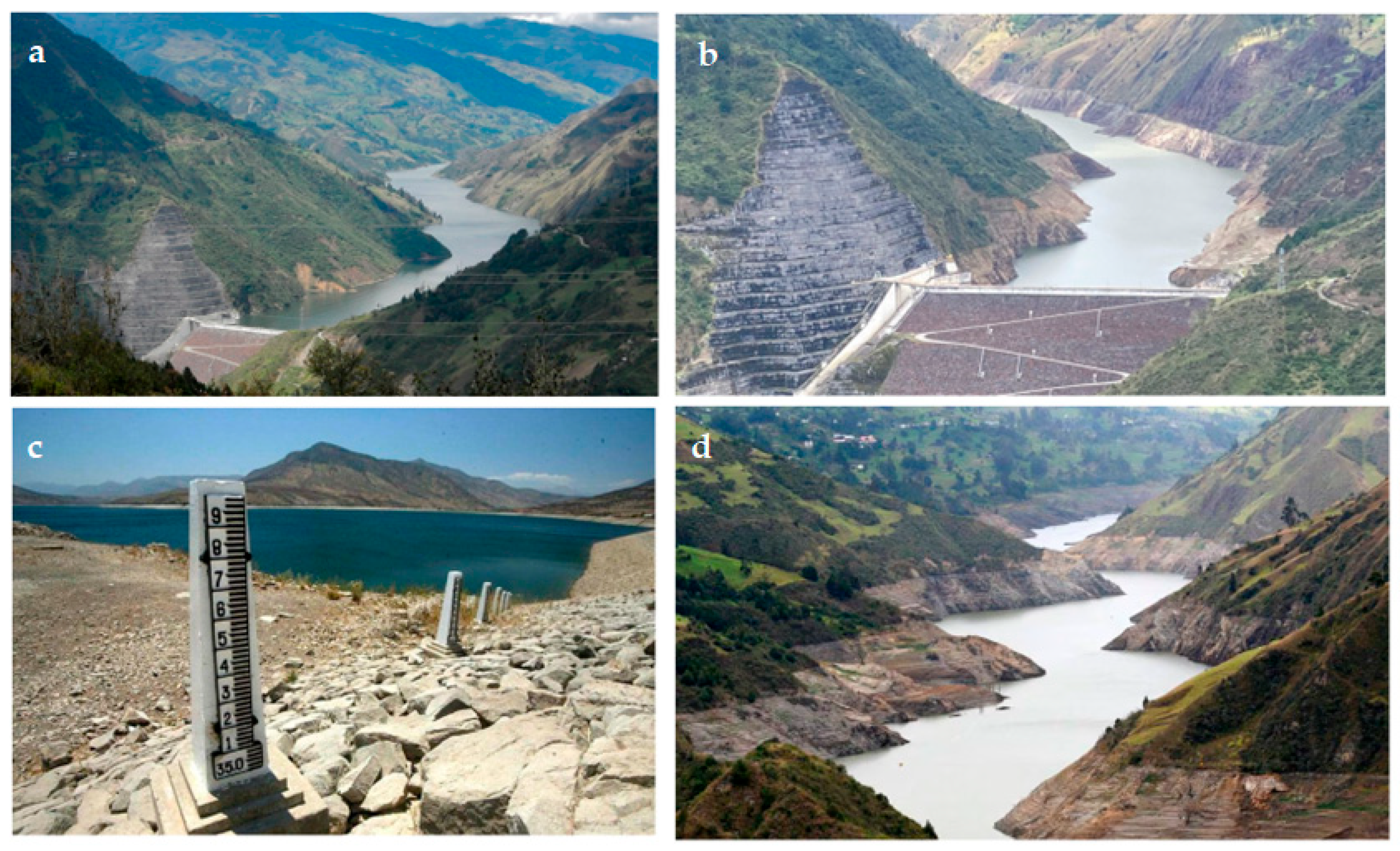


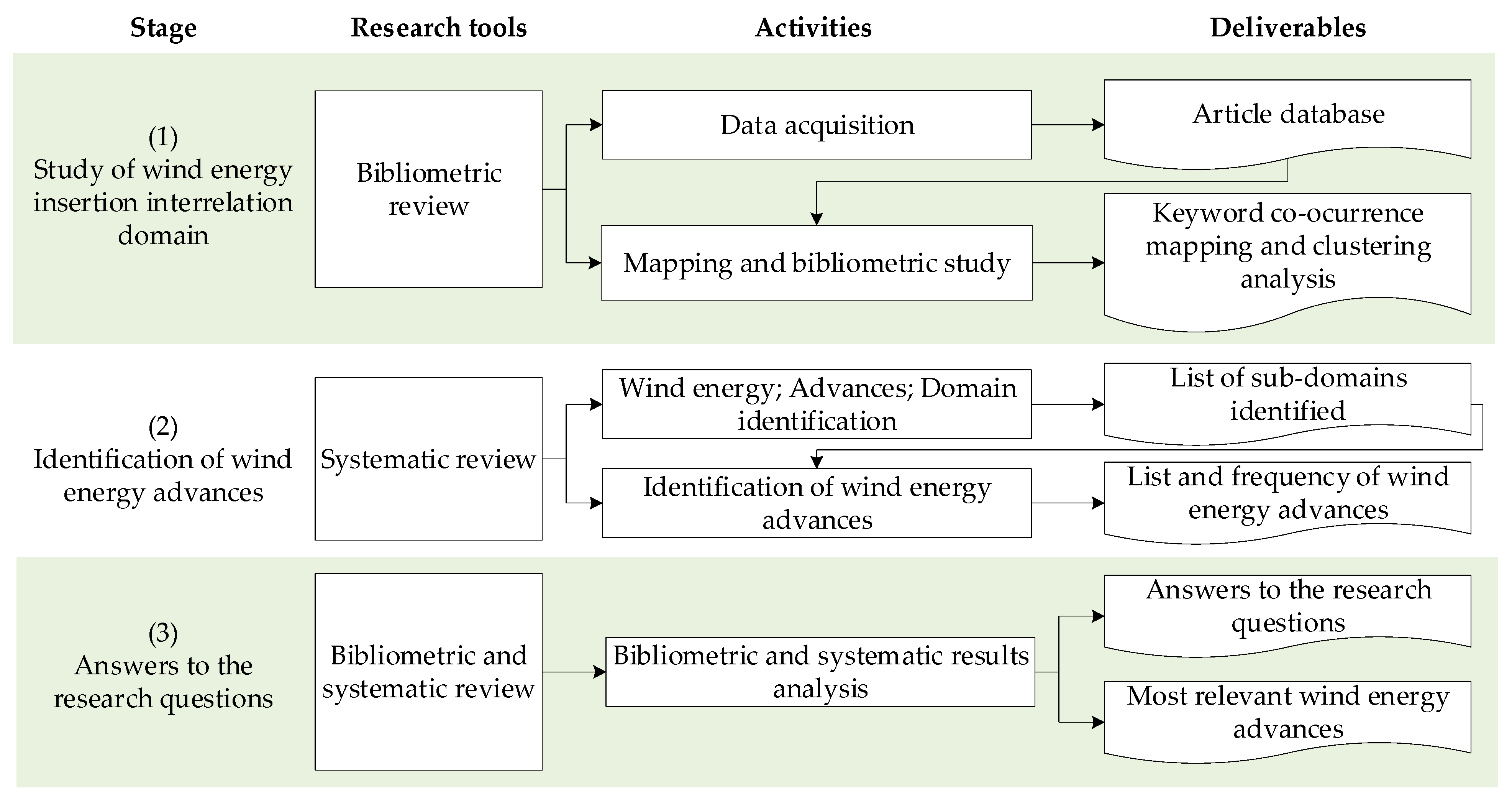
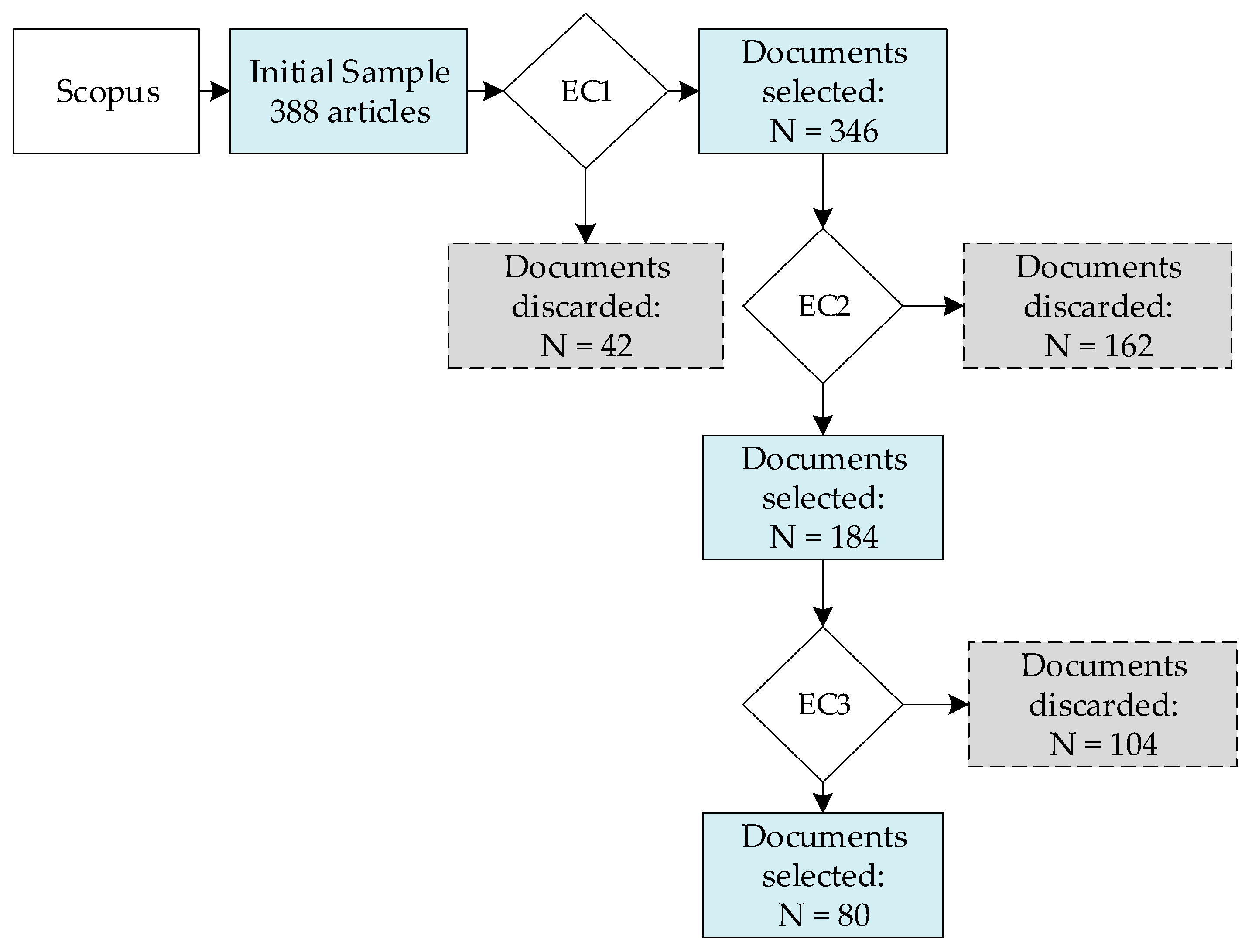


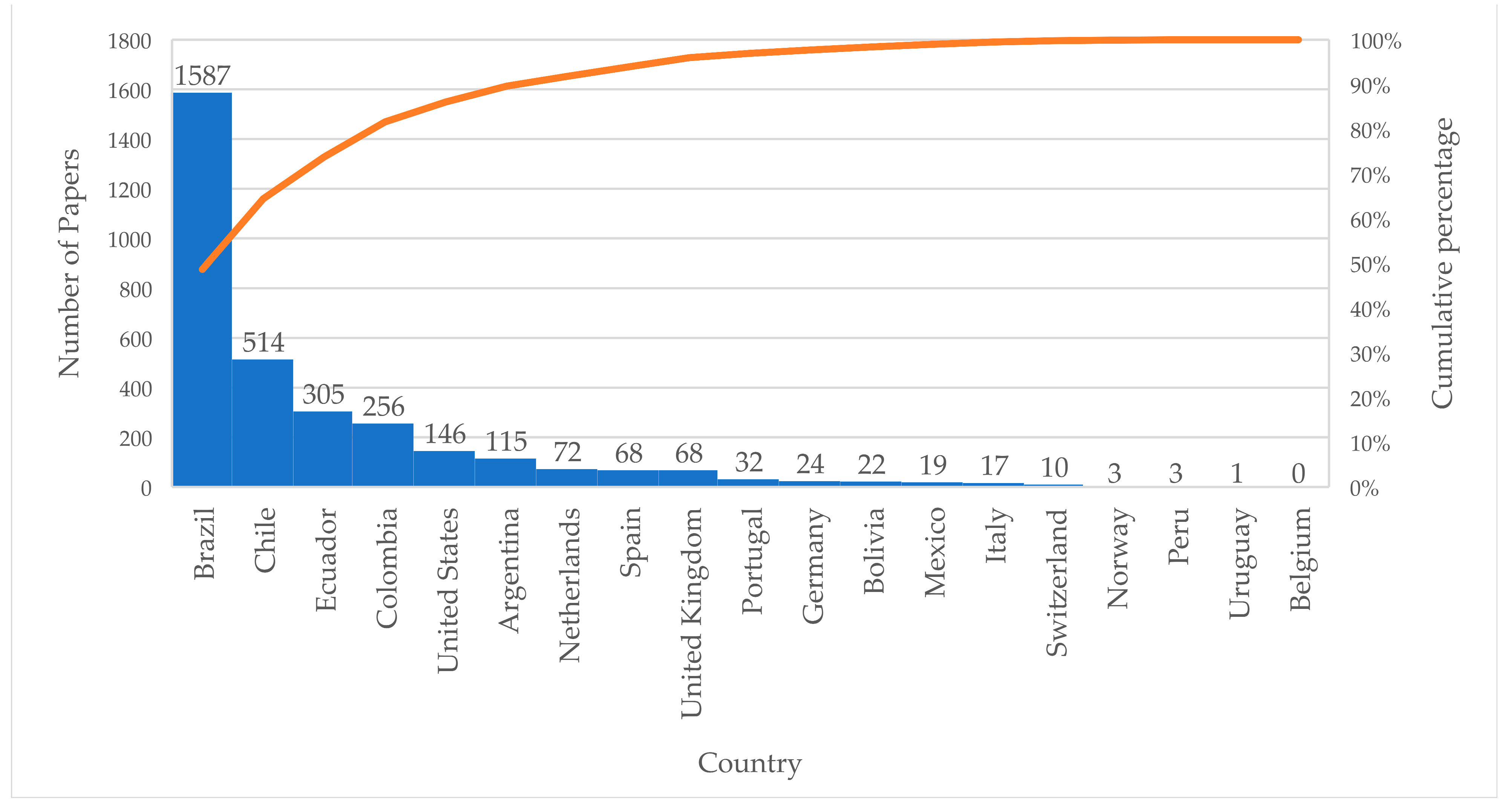
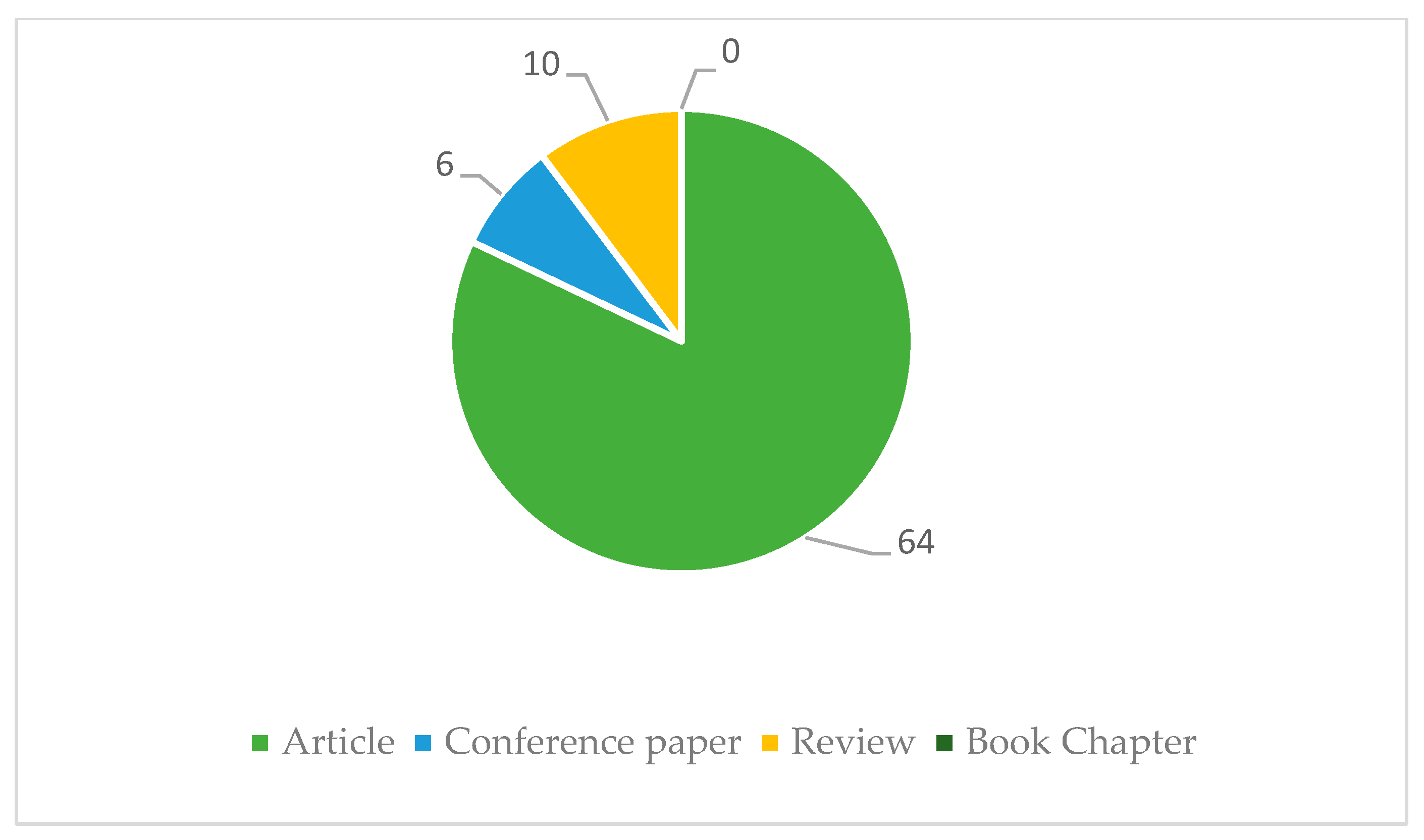

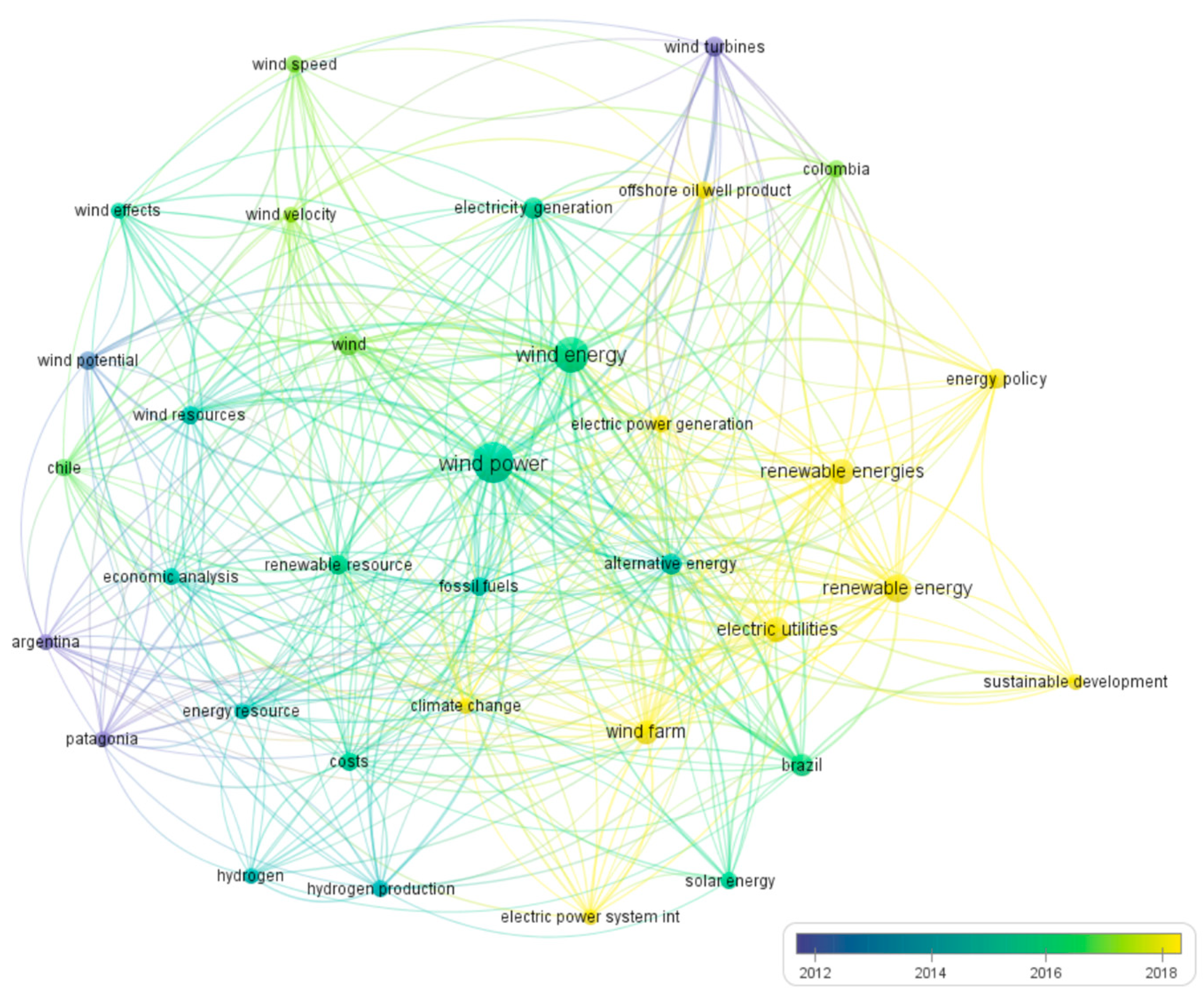

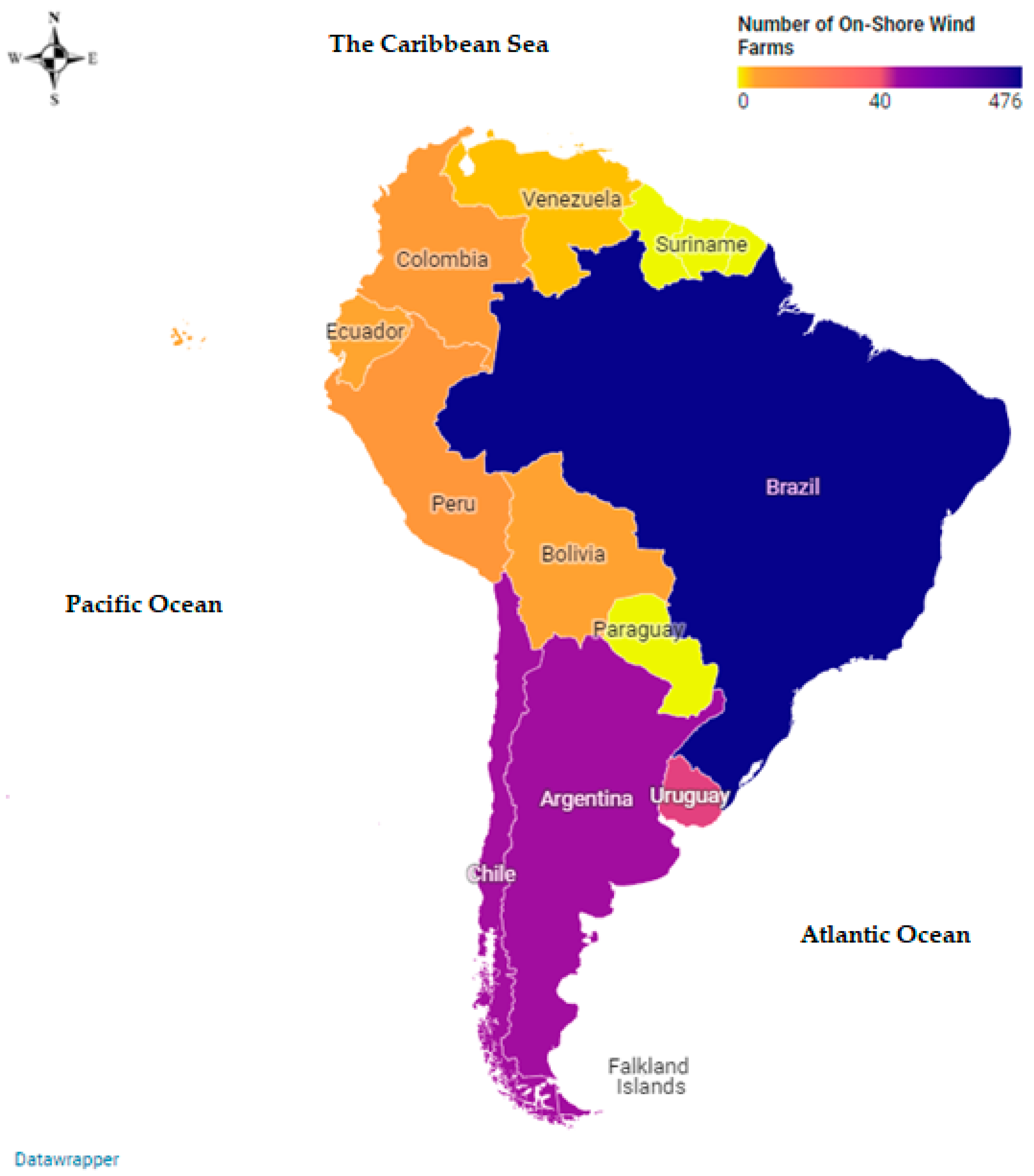
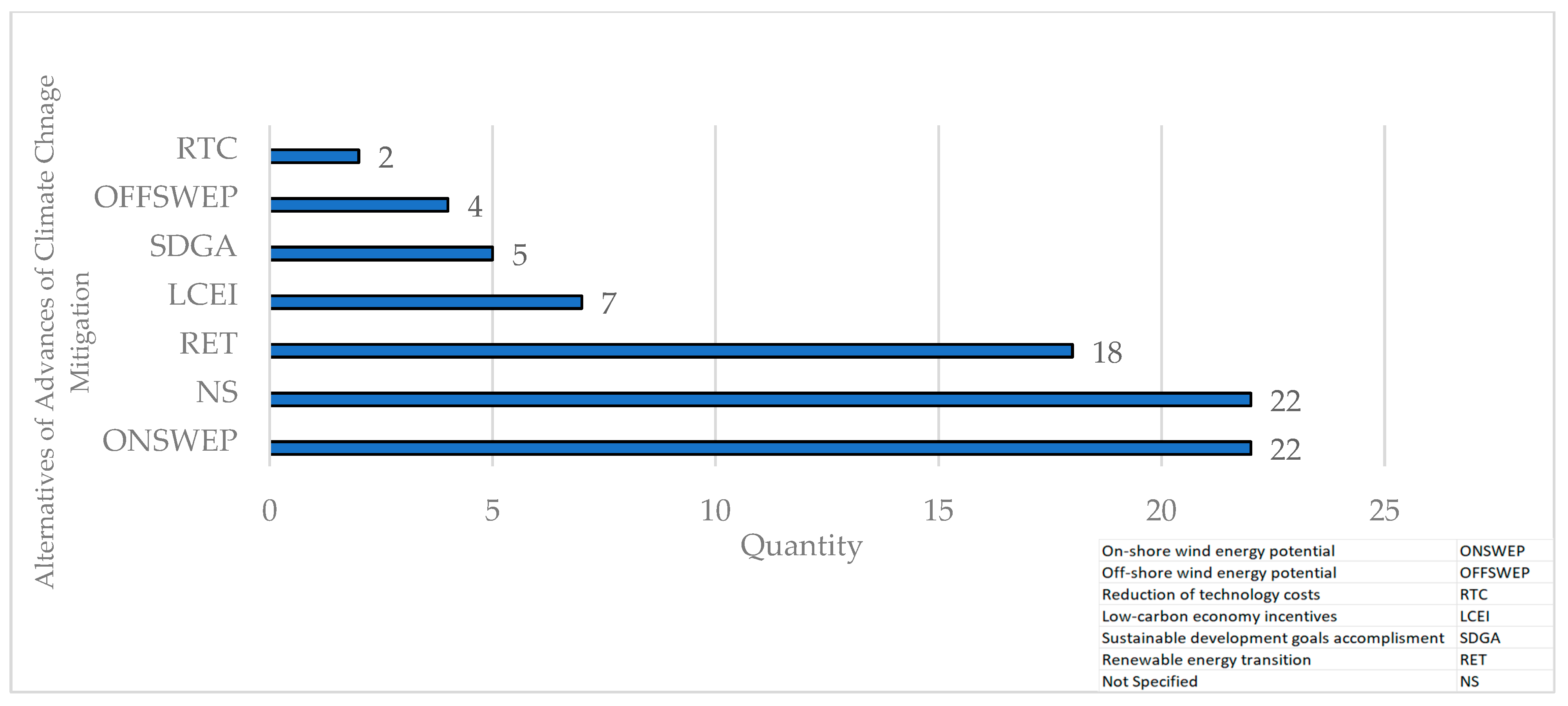
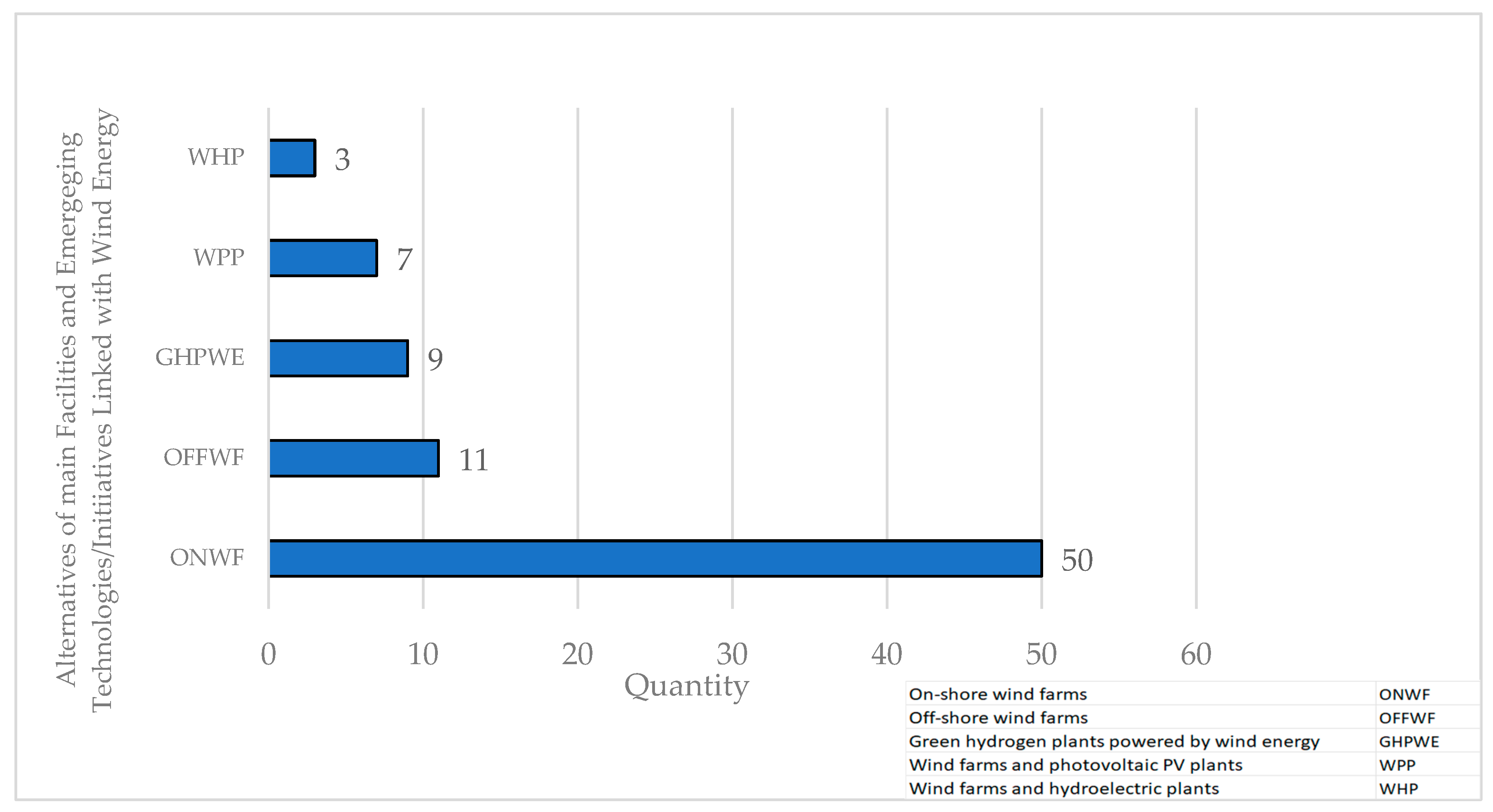

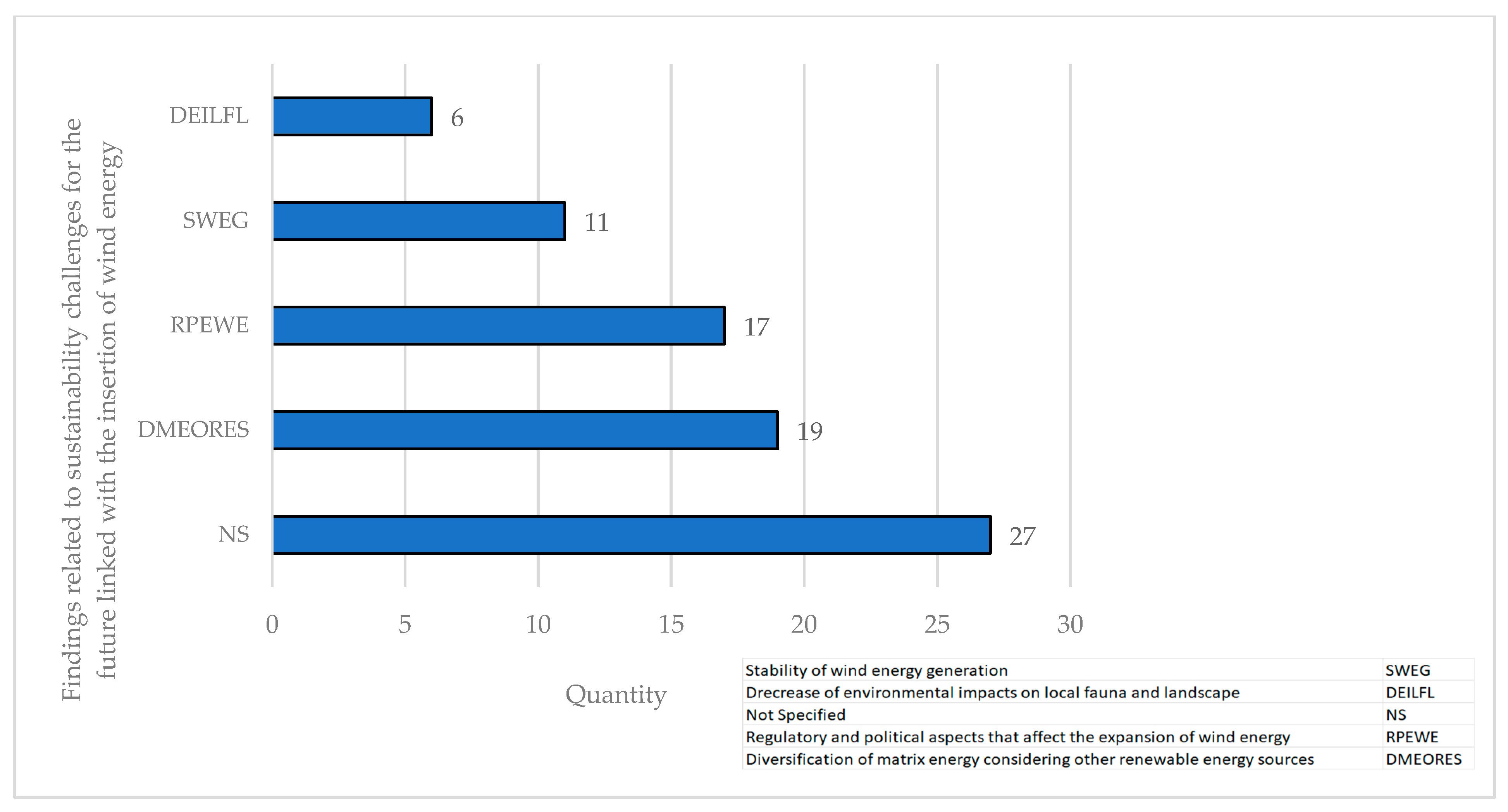


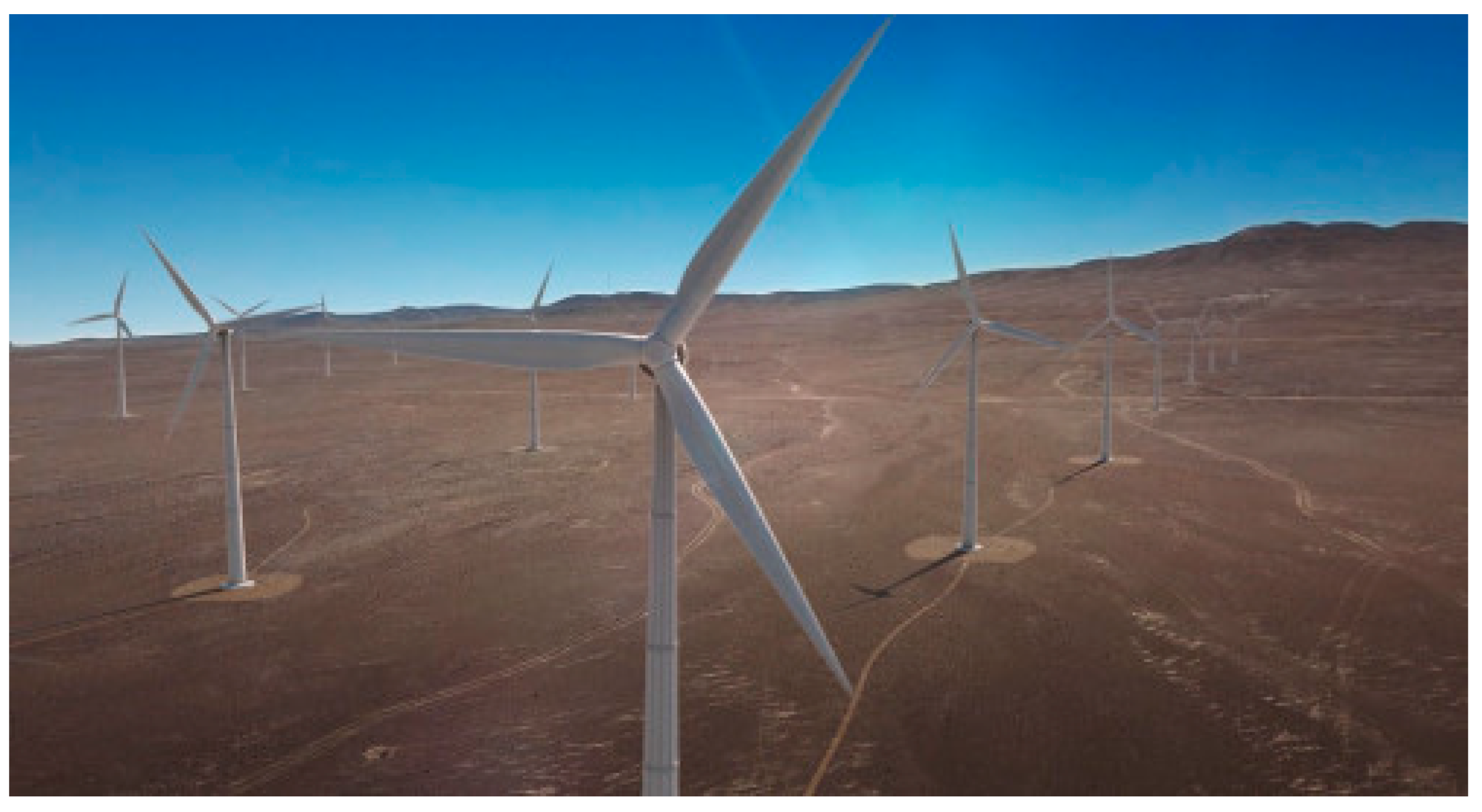


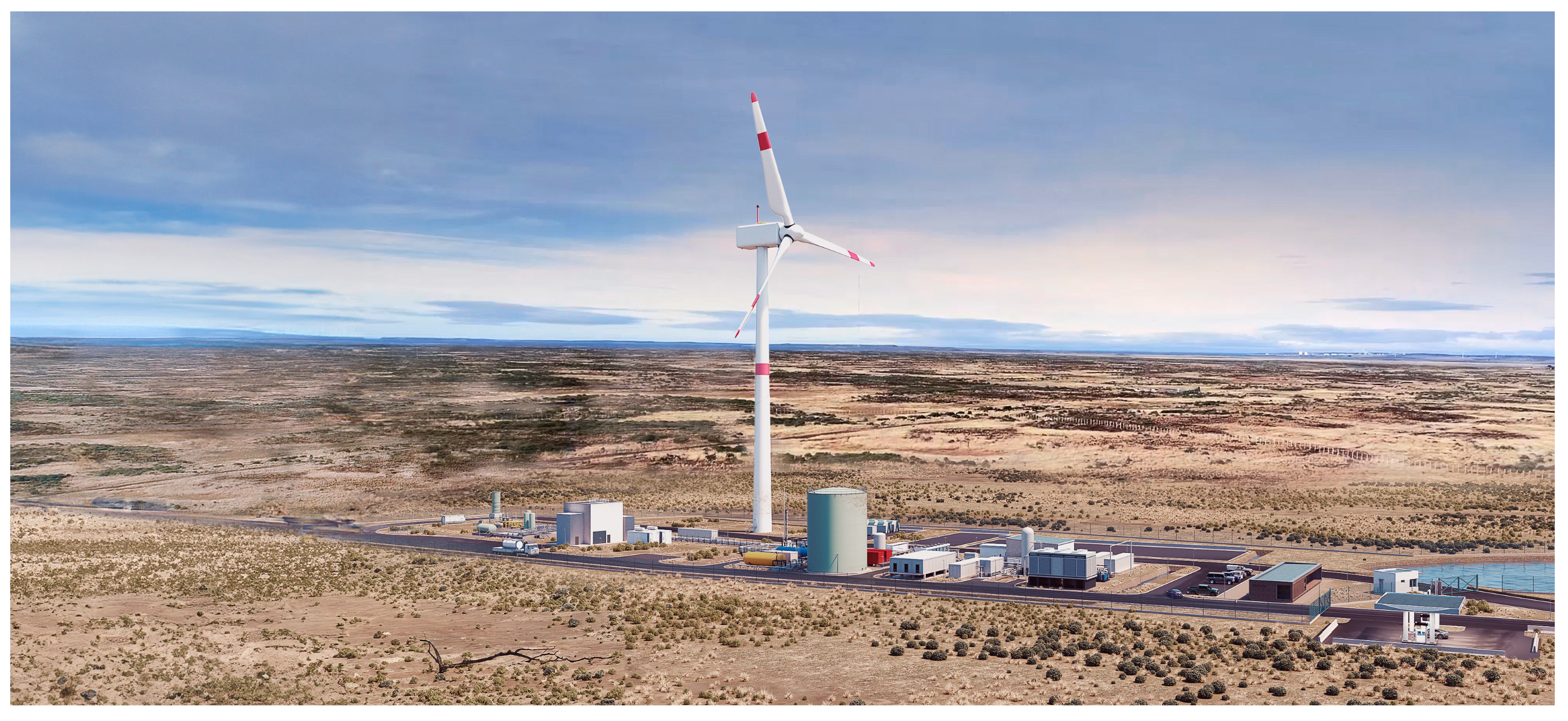
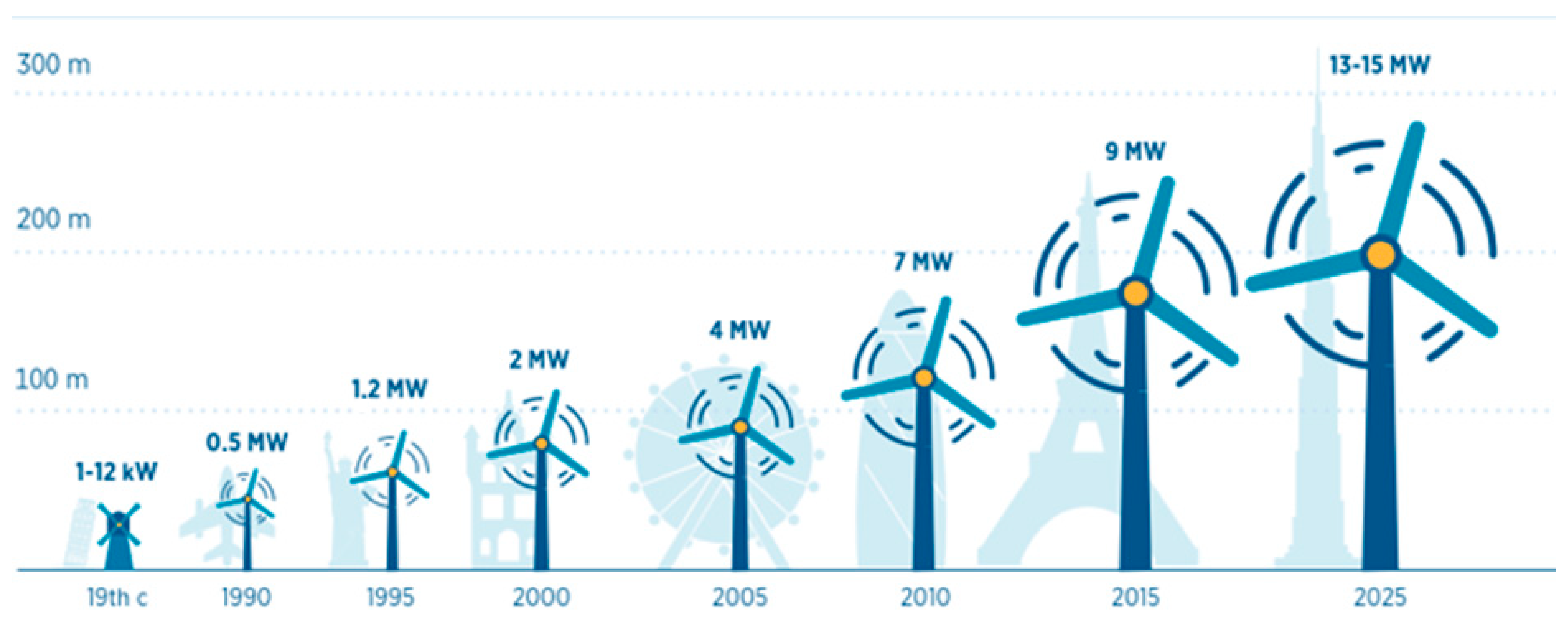

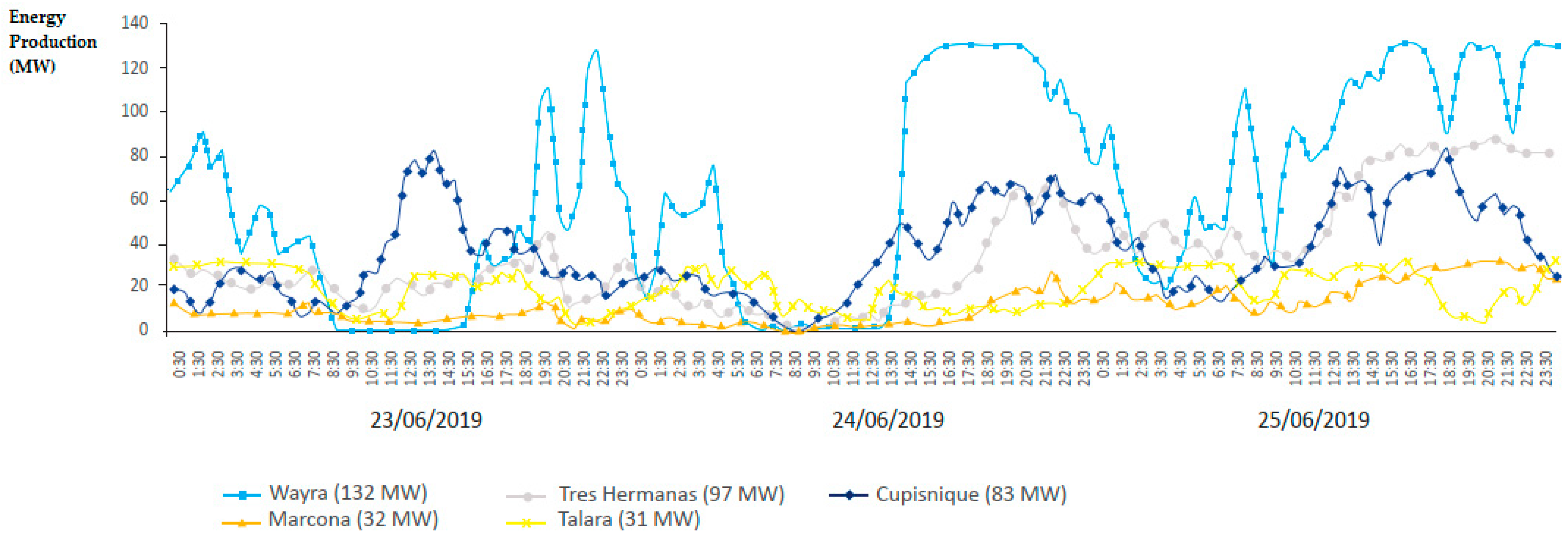
| Keywords | Boolean Operator | Keywords | Boolean Operator | Keywords |
|---|---|---|---|---|
| Wind | AND | Energy | AND | Argentina |
| Bolivia | ||||
| Brazil | ||||
| Chile | ||||
| Colombia | ||||
| Ecuador | ||||
| Paraguay | ||||
| Peru | ||||
| Venezuela | ||||
| Uruguay | ||||
| South America |
| Id. | Criteria | Field | Question | Data |
|---|---|---|---|---|
| DEM 1 | Metadata perspective | Keywords | What are the keywords? | Keywords |
| DEM 2 | Metadata perspective | Title | What is the name? | Name |
| DEM 3 | Metadata perspective | Authors | Who are the authors? | Authors List |
| DEM 4 | Metadata perspective | Year | What is the publication year? | Year |
| DEM 5 | Metadata perspective | Country | What is the country of the first author? | Country |
| DEM 6 | Metadata perspective | Citation count | How many citations does the document have? | Number |
| DEM 7 | Metadata perspective | Document Type | What is the name of the type of document? | Conference paper or Article or Review or Other |
| DEC8 | Content-based perspective | Popular Clusters | RQ1: What are the main clusters of wind energy concepts applied for implementation of this technology in South America and how do they evolve over time? | e.g., on-shore wind energy, off-shore wind energy, green hydrogen, among others |
| DEC9 | Content-based perspective | On-shore Wind Energy Potential and Installed Capacity | RQ2: What is the on-shore wind energy installed capacity (MW) and usable potential (MW) in each country of South America? | e.g., 9000 MW installed capacity and 12,000 MW energy potential, among others |
| DEC10 | Content-based perspective | On-shore Wind Annual Energy Production and Reduction Rate of GHGs | RQ3: What is the annual energy production (GWh) from on-shore wind farms and what is the related reduction rate of greenhouse gasses (GHGs) in each country of South America? | e.g., 50,000 MWh, 2.5 Mt eq CO2, among others |
| DEC11 | Content-based perspective | Quantity of Wind Farm Facilities | RQ4: Which South American countries have more development of on-shore wind energy considering the quantity of wind farm facilities under operation? | e.g., 10, 33, 120, among others |
| DEC12 | Content-based perspective | Climate Change Mitigation Advances | RQ5: What are the main advances related to climate change mitigation considering the implementation of wind energy in South America? | e.g., low-carbon economy incentives and clean energy transition, among others |
| DEC13 | Content-based perspective | Emerging technologies/initiatives | RQ6: What are the main facilities and emerging technologies/initiatives linked with wind energy considering private investment projects in South America? | e.g., green hydrogen produced with wind energy, and hybridization with solar PV, among others |
| DEC14 | Content-based perspective | Research and development (R&D) studies/projects | RQ7: What are the universities’ main research and development (R&D) studies/projects to insert wind energy in South America? | e.g., improving wind turbine efficiency, integration of wind energy to smart grids, among others |
| DEC15 | Content-based perspective | Sustainability challenges | RQ8: What are the main sustainability challenges for the future linked with the implementation of wind energy in South America? | e.g., stability of wind energy generation, and decrease in environmental impacts on local fauna and landscape, among others |
| Cluster Name | Keywords | Cluster Definition |
|---|---|---|
| Cluster “Yellow” | Hydrogen, costs, fossil fuels, climate change | Hydrogen production |
| Cluster “Blue” | Wind turbines, off-shore oil well production, electricity generation | Off-shore wind energy |
| Cluster “Red” | Renewable resources, wind speed, energy resource | Wind potential |
| Cluster “Green” | Wind energy, wind farm, energy policy, sustainable development | Renewable energy |
| Cluster Name | Keywords | Period of Publication | Cluster Definition |
|---|---|---|---|
| Cluster “Blue” | Wind potential, wind resources, wind turbines | 2012–2014 | Wind energy potential |
| Cluster “Green” | Wind energy, wind power, renewable resources | 2014–2016 | Renewable energy technology |
| Cluster “Yellow” | Renewable energy, energy policy, sustainable development | 2016–2018 | Sustainability |
| Country | Installed Capacity (MW) | Usable Potential (MW) | Percentage Used of Potential (%) |
|---|---|---|---|
| Argentina | 4363 | 300,000 | 1.5 |
| Bolivia | 135 | 100,000 | 0.1 |
| Brazil | 25,055 | 700,000 | 3.6 |
| Chile | 5993 | 40,000 | 15.0 |
| Colombia | 913 | 30,000 | 3.0 |
| Ecuador | 78 | 4000 | 2.0 |
| Paraguay | 0 | 2000 | 0.0 |
| Peru | 978 | 20,500 | 4.8 |
| Uruguay | 1645 | 40,000 | 4.1 |
| Venezuela | 138 | 45,000 | 0.3 |
| South America | 39,298 | 1,281,500 | 3.1 |
| Mexico | 7318 | 50,000 | 14.6 |
| USA | 144,429 | 10,640,080 | 1.4 |
| China | 335,504 | 2,968,000 | 11.0 |
| Parameters (Year 2020) | Units | Argentina | Brazil | Bolivia | Chile | Colombia | Ecuador | Paraguay | Peru | Uruguay | Venezuela | Mexico | USA | China |
|---|---|---|---|---|---|---|---|---|---|---|---|---|---|---|
| Electricity generated from on-shore wind energy | GWh | 9412 | 57,050 | 64.21 | 5602 | 10.12 | 77.1 | N/A | 1814 | 5476 | 88 | 19,701 | 341,818 | 467,037 |
| GHG emissions generated from on-shore wind energy | Mt CO2eq | 0.1 | 0.7 | 0 | 0.1 | 0 | 0 | N/A | 0 | 0.1 | 0 | 0.2 | 4.1 | 5.6 |
| Avoided GHG emissions from on-shore wind energy | Mt CO2eq | 4.10 | 29.30 | 0.03 | 4.5 | 0.01 | 0.06 | N/A | 0.9 | 4.5 | 0.04 | 9.67 | 164.20 | 417.40 |
| Country | Number of On-Shore Wind Farms | Number of Wind Turbines |
|---|---|---|
| Argentina | 75 | 2182 |
| Bolivia | 5 | 68 |
| Brazil | 476 | 12,528 |
| Chile | 66 | 2997 |
| Colombia | 8 | 457 |
| Ecuador | 4 | 39 |
| Paraguay | 0 | 0 |
| Peru | 10 | 489 |
| Uruguay | 48 | 823 |
| Venezuela | 2 | 69 |
| South America | 694 | 19,649 |
| # | Authors | Year | (i) | (ii) | (iii) | (iv) |
|---|---|---|---|---|---|---|
| 1 | Mattar and Guzmán-Ibarra [42] | 2017 | RTC | OFFWF | IWESG | NS |
| 2 | Da Silva et al. [43] | 2005 | RET | GHPWE | DHT | SWEG |
| 3 | De Bona et al. [44] | 2021 | ONSWEP | ONWF | IWTE | NS |
| 4 | Dos Santos et al. [45] | 2021 | NS | WPP | IWESG | DMEORES |
| 5 | Rodríguez et al. [46] | 2010 | LCEI | GHPWE | DHT | SWEG |
| 6 | Valença and Bernard [47] | 2015 | NS | ONWF | REI | DEILFL |
| 7 | De Azevedo et al. [48] | 2020 | OFFSWEP | OFFWF | IWESG | NS |
| 8 | Carvajal-Romo et al. [49] | 2019 | ONSWEP | WPP | DHT | DMEORES |
| 9 | Watts et al. (1) [50] | 2016 | ONSWEP | ONWF | CETP | NS |
| 10 | Diógenes et al. [51] | 2019 | NS | ONWF | PRMS | RPEWE |
| 11 | Bernard et al. [52] | 2014 | NS | ONWF | PRMS | DEILFL |
| 12 | Falavigna et al. [53] | 2020 | NS | ONWF | REI | DEILFL |
| 13 | Castillo et al. [54] | 2018 | NS | WHP | DHT | DMEORES |
| 14 | de Medeiros Galvão et al. [55] | 2020 | ONSWEP | ONWF | CETP | NS |
| 15 | Ottoni Salles et al. [56] | 2019 | LCEI | ONWF | IWESG | RPEWE |
| 16 | Lozer dos Reis et al. [57] | 2021 | OFFSWEP | OFFWF | CETP | SWEG |
| 17 | Bastidas-Salamanca and Rueda-Bayona [58] | 2021 | LCEI | OFFWF | IWESG | SWEG |
| 18 | Hernandez et al. [59] | 2021 | NS | OFFWF | REI | RPEWE |
| 19 | De Jong et al. [60] | 2019 | ONSWEP | ONWF | IWTE | DMEORES |
| 20 | Tito et al. [61] | 2020 | ONSWEP | ONWF | IWTE | NS |
| 21 | Botero at al. [62] | 2010 | LCEI | ONWF | IWESG | RPEWE |
| 22 | Armijo and Philibert [63] | 2020 | NS | GHPWE | DHT | DMEORES |
| 23 | Neri et al. [64] | 2019 | SDGA | ONWF | CETP | DEILFL |
| 24 | Watts et al. (2) [65] | 2017 | NS | ONWF | IWTE | SWEG |
| 25 | Ramos Júnior et al. [66] | 2022 | SDGA | ONWF | IWESG | NS |
| 26 | Edsand [67] | 2017 | ONSWEP | ONWF | IWESG | DEILFL |
| 27 | Vallejos-Romero et al. [68] | 2020 | RET | WHP | PRMS | RPEWE |
| 28 | Nadaleti et al. [69] | 2020 | ONSWEP | GHPWE | DHT | DMEORES |
| 29 | Dalbem et al. [70] | 2014 | NS | ONWF | PRMS | NS |
| 30 | Bianchi et al. [71] | 2017 | ONSWEP | ONWF | IWTE | SWEG |
| 31 | Mönnich et al. [72] | 2004 | ONSWEP | GHPWE | DHT | DMEORES |
| 32 | Zolezzi et al. [73] | 2010 | ONSWEP | GHPWE | DHT | DMEORES |
| 33 | Maximov et al. [74] | 2010 | RET | ONWF | IWESG | NS |
| 34 | Icaza et al. (1) [75] | 2020 | ONSWEP | ONWF | IWESG | NS |
| 35 | Frate-Albuquerque and Caldeira-Pires [76] | 2005 | RET | ONWF | PRMS | RPEWE |
| 36 | Pereira et al. (1) [77] | 2022 | NS | ONWF | REI | DEILFL |
| 37 | Farkat Diógenes et al. [78] | 2020 | NS | ONWF | PRMS | RPEWE |
| 38 | Araújo and Gorayeb [79] | 2023 | NS | ONWF | PRMS | RPEWE |
| 39 | Soares et al. [80] | 2021 | RET | ONWF | PRMS | RPEWE |
| 40 | Levieux et al. [81] | 2019 | NS | WHP | DHT | DMEORES |
| 41 | Icaza et al. (2) [82] | 2018 | ONSWEP | ONWF | IWTE | NS |
| 42 | Rueda-Bayona et al. (1) [83] | 2019 | LCEI | OFFWF | IWESG | RPEWE |
| 43 | Mejía et al. [84] | 2006 | RET | ONWF | IWTE | NS |
| 44 | Spazzafumo [85] | 2013 | RET | GHPWE | DHT | DMEORES |
| 45 | Cevallos-Sierra and Ramos-Martin [86] | 2018 | RET | WPP | DHT | DMEORES |
| 46 | González-Longatt et al. (1) [87] | 2015 | OFFSWEP | OFFWF | IWTE | NS |
| 47 | Weiss et al. [88] | 2018 | ONSWEP | ONWF | IWTE | SWEG |
| 48 | Watts and Jara [89] | 2011 | RET | ONWF | IWESG | NS |
| 49 | Sigal et al. [90] | 2015 | LCEI | GHPWE | DHT | DMEORES |
| 50 | Rego and De Oliveira Ribeiro [91] | 2018 | LCEI | ONWF | IWESG | NS |
| 51 | Riojas-Díaz et al. [92] | 2022 | RET | ONWF | DHT | DMEORES |
| 52 | De Lara Filho et al. [93] | 2019 | RET | WPP | DHT | DMEORES |
| 53 | Candia et al. [94] | 2019 | RET | WPP | DHT | DMEORES |
| 54 | Gonçalves et al. [95] | 2020 | SDGA | ONWF | CETP | NS |
| 55 | Pereira et al. (2) [96] | 2013 | NS | ONWF | IWTE | NS |
| 56 | Nadaleti et al. (1) [97] | 2020 | ONSWEP | GHPWE | DHT | DMEORES |
| 57 | Ardanche et al. [98] | 2018 | NS | ONWF | PRMS | RPEWE |
| 58 | Moraes et al. [99] | 2016 | RTC | ONWF | IWESG | NS |
| 59 | Arroyo and Miguel [100] | 2020 | RET | ONWF | IWESG | DMEORES |
| 60 | Coelho and Pinho [101] | 2017 | RET | OFFWF | IWTE | RPEWE |
| 61 | Mattar et al. [102] | 2021 | OFFSWEP | OFFWF | PRMS | RPEWE |
| 62 | Osorio-Aravena et al. [103] | 2020 | SDGA | WPP | IWESG | DMEORES |
| 63 | Mamani and Hendrick (1) [104] | 2022 | NS | ONWF | IWTE | SWEG |
| 64 | Benzo et al. [105] | 2020 | NS | ONWF | IWTE | SWEG |
| 65 | Rueda-Bayona et al. (2) [106] | 2019 | NS | OFFWF | IWTE | NS |
| 66 | Carvalho [107] | 2003 | RET | ONWF | IWESG | NS |
| 67 | Filgueiras and Silva [108] | 2003 | NS | ONWF | IWESG | RPEWE |
| 68 | De Lima Camargo et al. [109] | 2019 | RET | ONWF | IWESG | RPEWE |
| 69 | Silva et al. [110] | 2013 | NS | ONWF | IWTE | NS |
| 70 | Labriola and Palese [111] | 2000 | ONSWEP | ONWF | NS | NS |
| 71 | Becerra et al. [112] | 2017 | ONSWEP | ONWF | IWTE | NS |
| 72 | Labriola [113] | 2007 | RET | ONWF | IWESG | NS |
| 73 | Recalde [114] | 2010 | ONSWEP | ONWF | PRMS | RPEWE |
| 74 | Mamani and Hendrick (2) [115] | 2022 | ONSWEP | ONWF | IWTE | NS |
| 75 | González-Longatt [116] | 2015 | RET | ONWF | IWESG | NS |
| 76 | Nelson and Caldera [117] | 1987 | ONSWEP | ONWF | NS | RPEWE |
| 77 | Love and Garwood [118] | 2011 | NS | WPP | DHT | DMEORES |
| 78 | González-Longatt et al. (2) [119] | 2014 | ONSWEP | ONWF | IWTE | SWEG |
| 79 | Reboita et al. [120] | 2018 | ONSWEP | ONWF | IWTE | SWEG |
| 80 | Cacciuttolo et al. [121] | 2024 | SDGA | OFFWF | IWESG | NS |
| Ranking | Country | Installed Capacity (MW) | Number of On-Shore Wind Farms | Number of Wind Turbines | Usable Potential (MW) | Percentage Used of Potential (%) |
|---|---|---|---|---|---|---|
| 1 | Brazil | 25,055 | 476 | 12,528 | 700,000 | 3.6 |
| 2 | Chile | 5993 | 66 | 2997 | 40,000 | 15.0 |
| 3 | Argentina | 4363 | 75 | 2182 | 300,000 | 1.5 |
| 4 | Uruguay | 1645 | 48 | 823 | 40,000 | 4.1 |
| 5 | Peru | 978 | 10 | 489 | 20,500 | 4.8 |
| 6 | Colombia | 913 | 8 | 457 | 30,000 | 3.0 |
| 7 | Venezuela | 138 | 2 | 69 | 45,000 | 0.3 |
| 8 | Bolivia | 135 | 5 | 68 | 100,000 | 0.1 |
| 9 | Ecuador | 78 | 4 | 39 | 4000 | 2.0 |
| 10 | Paraguay | 0 | 0 | 0 | 2000 | 0.0 |
| Total | South America | 39,298 | 694 | 19,649 | 1,281,500 | 3.1 |
| Parameter | Value | Units |
|---|---|---|
| Location | Piauí region | - |
| Concession Owner | Enel Green Power Brasil | - |
| Type of Wind Farm | On-Shore | - |
| Number of Turbines | 230 | - |
| Turbines Manufacturer/Model | Nordex/Acciona AW125 | - |
| Diameter of Turbines | 125 | m |
| Hub Height | 120 | m |
| Installed Capacity per Turbine | 4.6 | MW |
| Total Installed Capacity | 1063.05 | MW |
| Capacity Factor | 0.50 | - |
| Parameter | Value | Units |
|---|---|---|
| Location | Rio Do Grande Do Norte Region | - |
| Concession Owner | Casa dos Ventos S.A. | - |
| Type of Wind Farm | On-Shore | - |
| Number of Turbines | 240 | - |
| Turbines Manufacturer/Model | Nordex/Acciona 4.3 MW | - |
| Diameter of Turbines | 125 | m |
| Hub Height | 120 | m |
| Installed Capacity per Turbine | 4.3 | MW |
| Total Installed Capacity | 1038 | MW |
| Capacity Factor | 0.50 | - |
| Parameter | Value | Units |
|---|---|---|
| Location | Taltal, Antofagasta Region | - |
| Concession Owner | Colbún S.A. | - |
| Type of Wind Farm | On-Shore | - |
| Number of Turbines | 140 | - |
| Turbines Manufacturer/Model | Enercon E-160 EP5 | - |
| Diameter of Turbines | 160 | m |
| Hub Height | 120 | m |
| Installed Capacity per Turbine | 5.8 | MW |
| Total Installed Capacity | 816 | MW |
| Capacity Factor | 0.55 | - |
| Parameter | Value | Units |
|---|---|---|
| Location | Tehuel Aike site, Cabo Negro, North of Punta Arenas, Magallanes Region | - |
| Concession Owner | HIF | - |
| Phase of the Project | Industrial Demonstration Plant | - |
| Type of Wind Farm | On-Shore | - |
| Number of Turbines | 1 | - |
| Turbines Manufacturer/Model | Siemens-Gamesa SG 3.4-132 | - |
| Diameter of Turbines | 132 | m |
| Hub Height | 100 | m |
| Installed Capacity per Turbine | 3.4 | MW |
| Total Installed Capacity | 3.4 | MW |
| Capacity Factor | 0.57 | - |
| Equivalent Operating Hours (EOH) | 5000 | Hours |
| Plant Surface | 3.7 | Ha |
| Electrolyzer Capacity | 1.2 | MW |
| e-fuel Production | 130,000 | L/year |
| e-methanol Production | 600 | Tons/year |
Disclaimer/Publisher’s Note: The statements, opinions and data contained in all publications are solely those of the individual author(s) and contributor(s) and not of MDPI and/or the editor(s). MDPI and/or the editor(s) disclaim responsibility for any injury to people or property resulting from any ideas, methods, instructions or products referred to in the content. |
© 2024 by the authors. Licensee MDPI, Basel, Switzerland. This article is an open access article distributed under the terms and conditions of the Creative Commons Attribution (CC BY) license (https://creativecommons.org/licenses/by/4.0/).
Share and Cite
Cacciuttolo, C.; Navarrete, M.; Atencio, E. Renewable Wind Energy Implementation in South America: A Comprehensive Review and Sustainable Prospects. Sustainability 2024, 16, 6082. https://doi.org/10.3390/su16146082
Cacciuttolo C, Navarrete M, Atencio E. Renewable Wind Energy Implementation in South America: A Comprehensive Review and Sustainable Prospects. Sustainability. 2024; 16(14):6082. https://doi.org/10.3390/su16146082
Chicago/Turabian StyleCacciuttolo, Carlos, Martin Navarrete, and Edison Atencio. 2024. "Renewable Wind Energy Implementation in South America: A Comprehensive Review and Sustainable Prospects" Sustainability 16, no. 14: 6082. https://doi.org/10.3390/su16146082
APA StyleCacciuttolo, C., Navarrete, M., & Atencio, E. (2024). Renewable Wind Energy Implementation in South America: A Comprehensive Review and Sustainable Prospects. Sustainability, 16(14), 6082. https://doi.org/10.3390/su16146082











